Connector including plate-shaped conductor and casing with through hole
Hirakawa , et al. February 23, 2
U.S. patent number 10,931,065 [Application Number 16/610,913] was granted by the patent office on 2021-02-23 for connector including plate-shaped conductor and casing with through hole. The grantee listed for this patent is I-PEX Inc., Wacom Co., Ltd.. Invention is credited to Takeshi Hirakawa, Naoto Onoda.
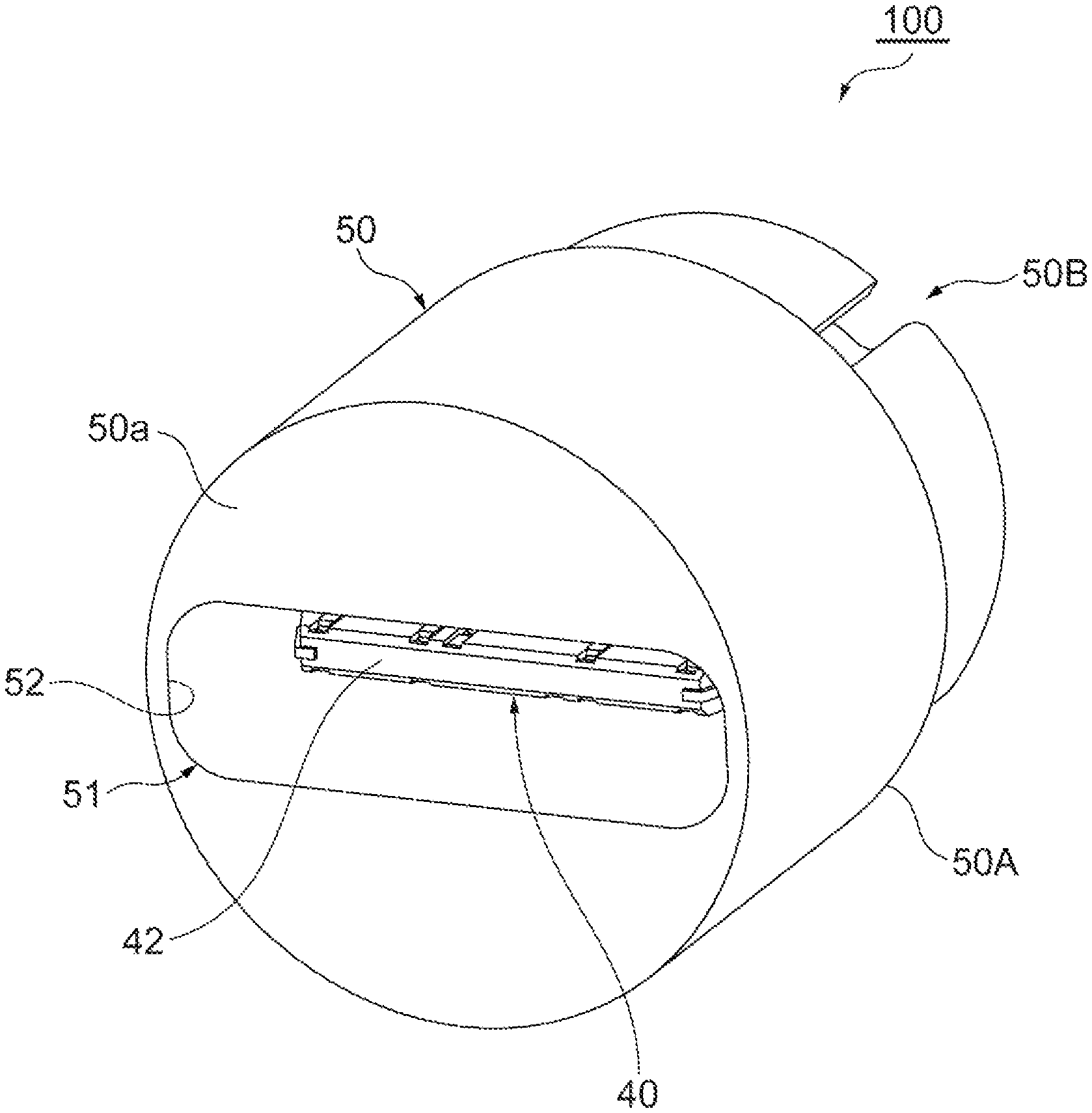
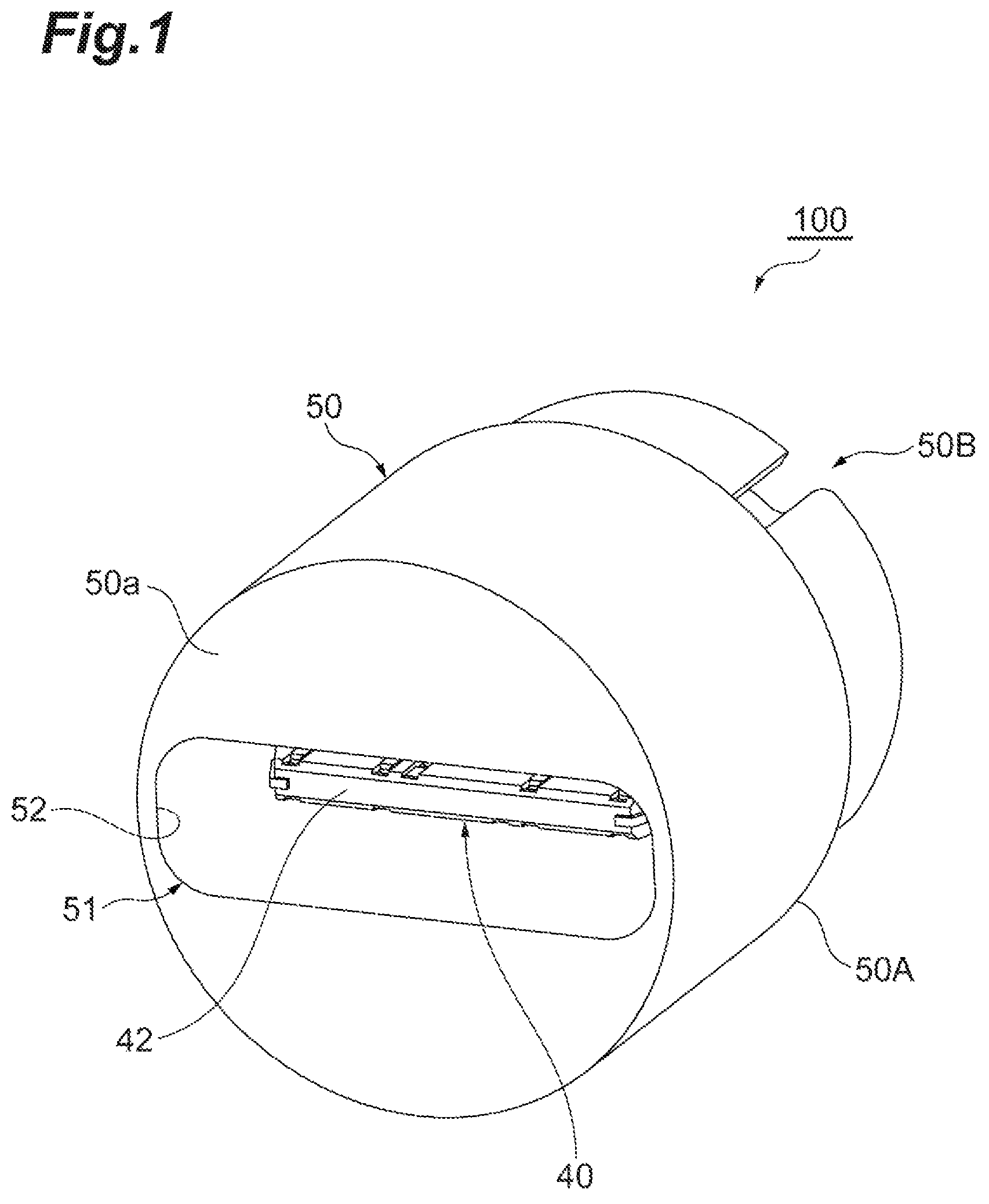
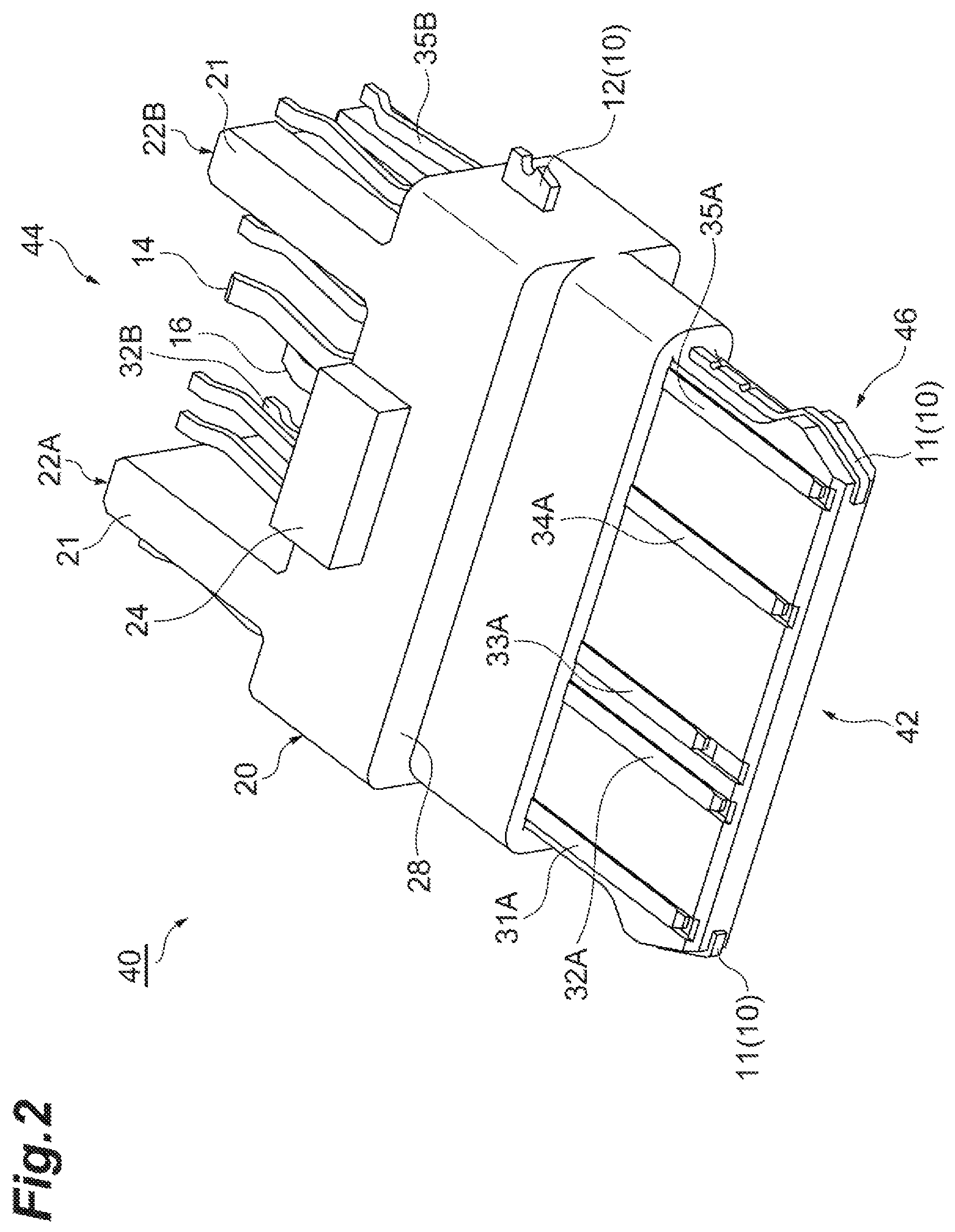

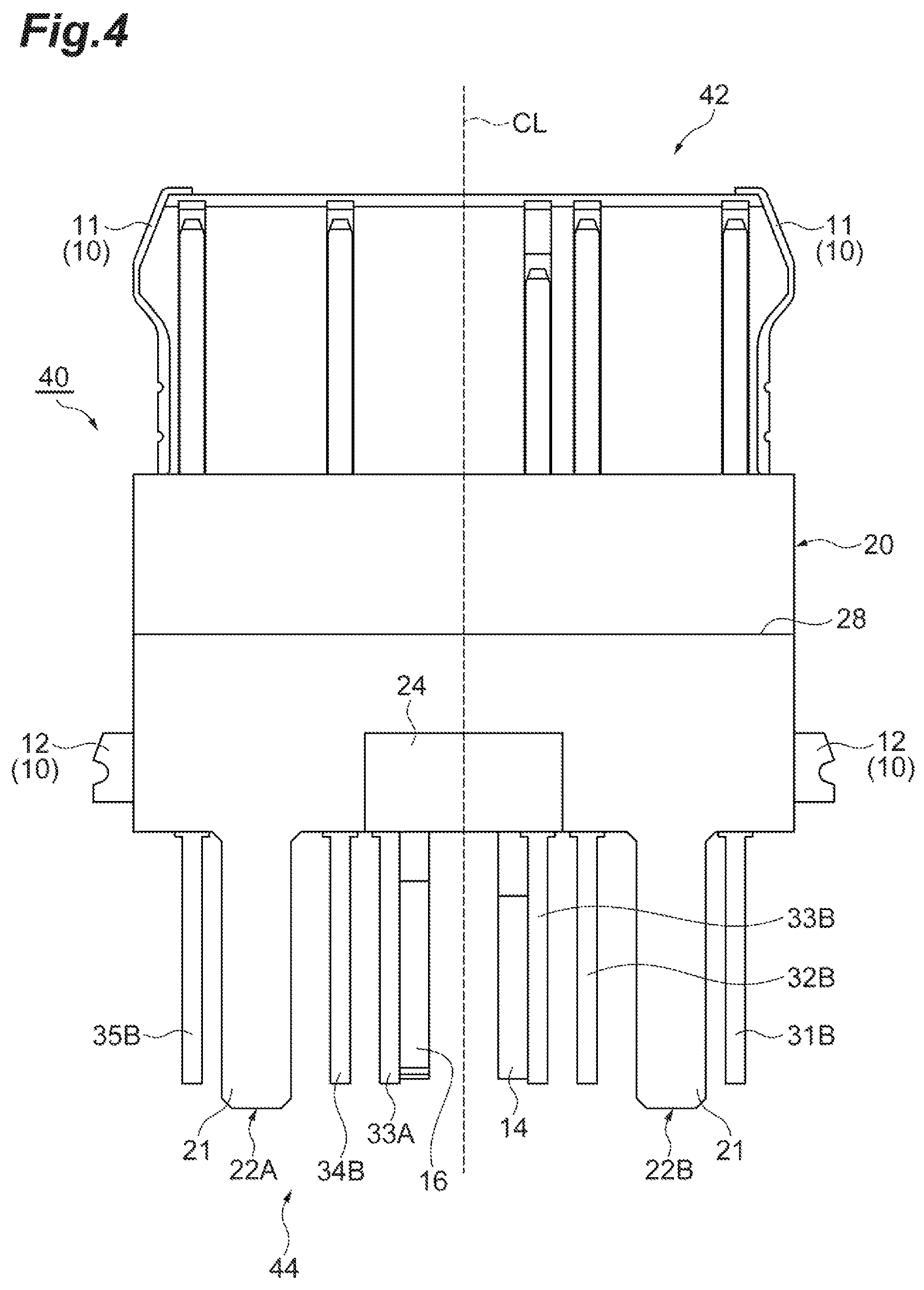
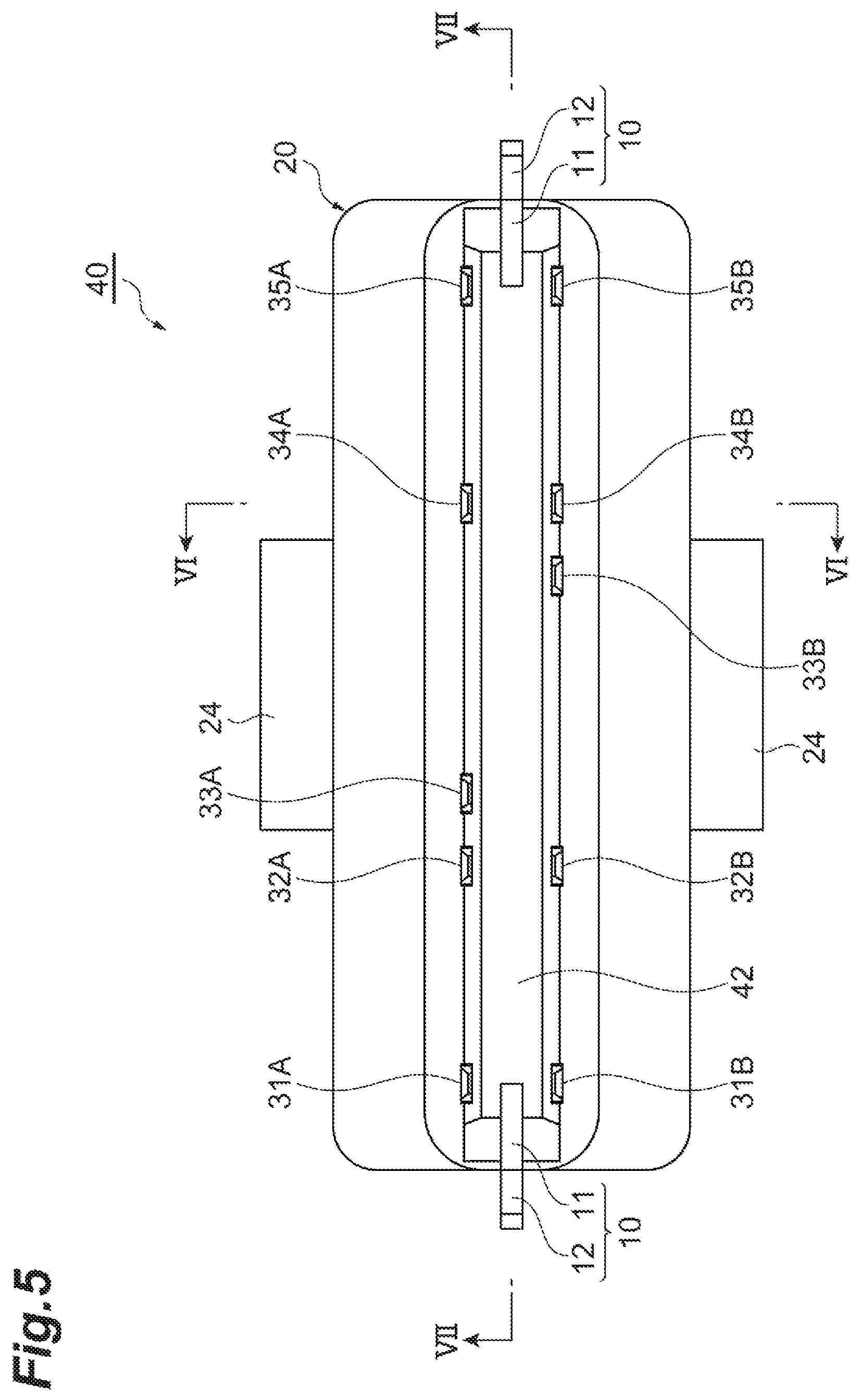
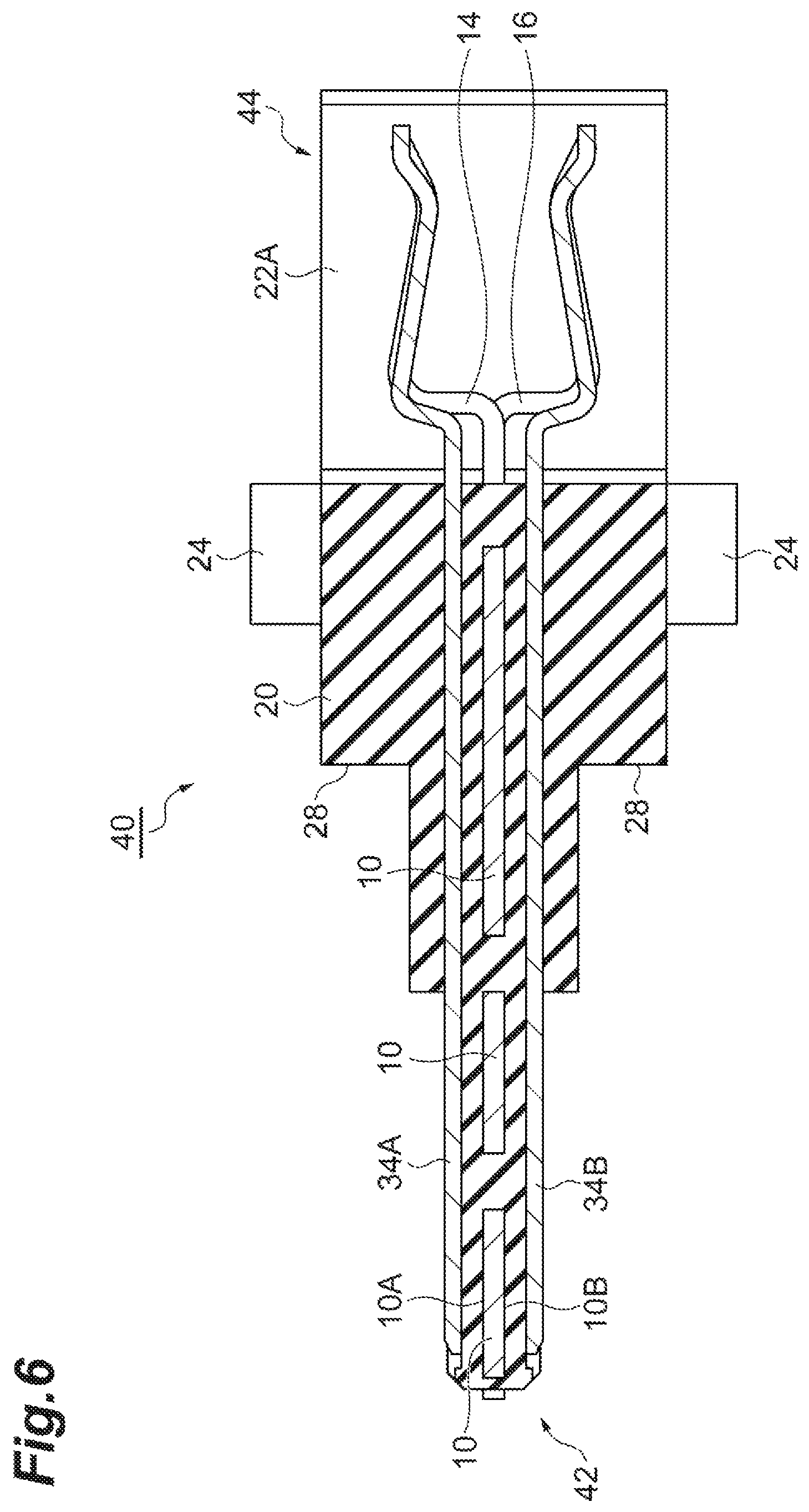
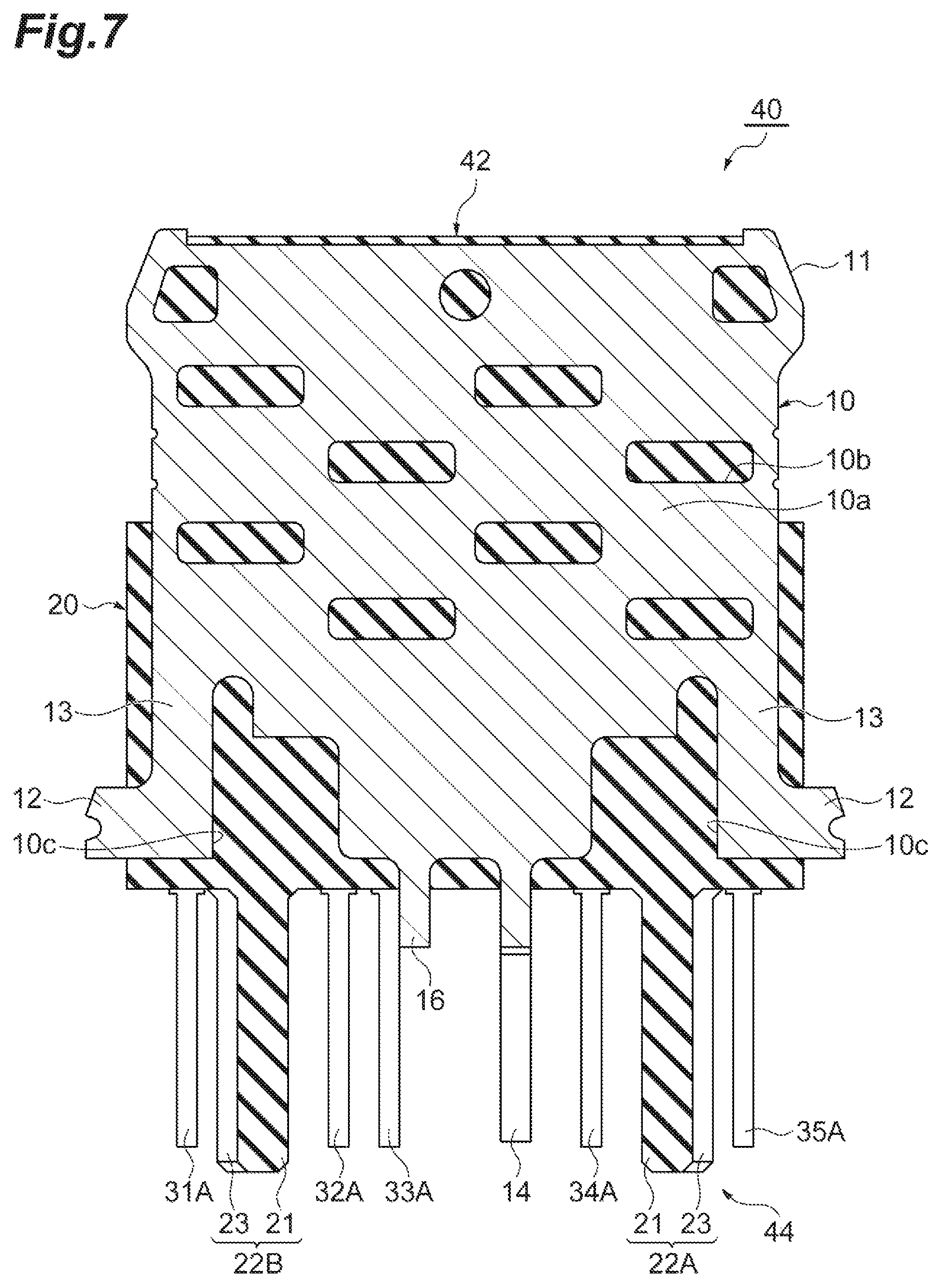
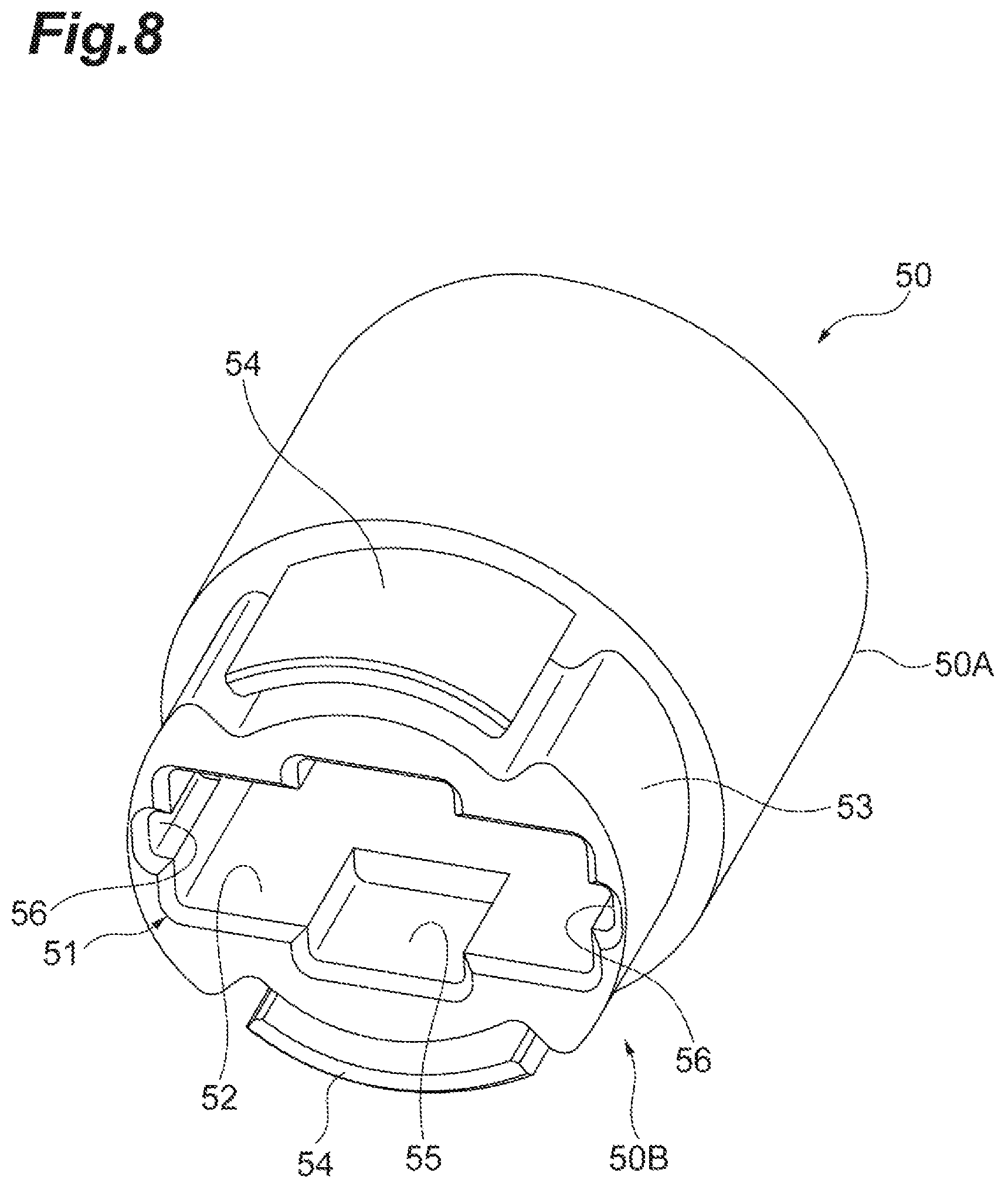
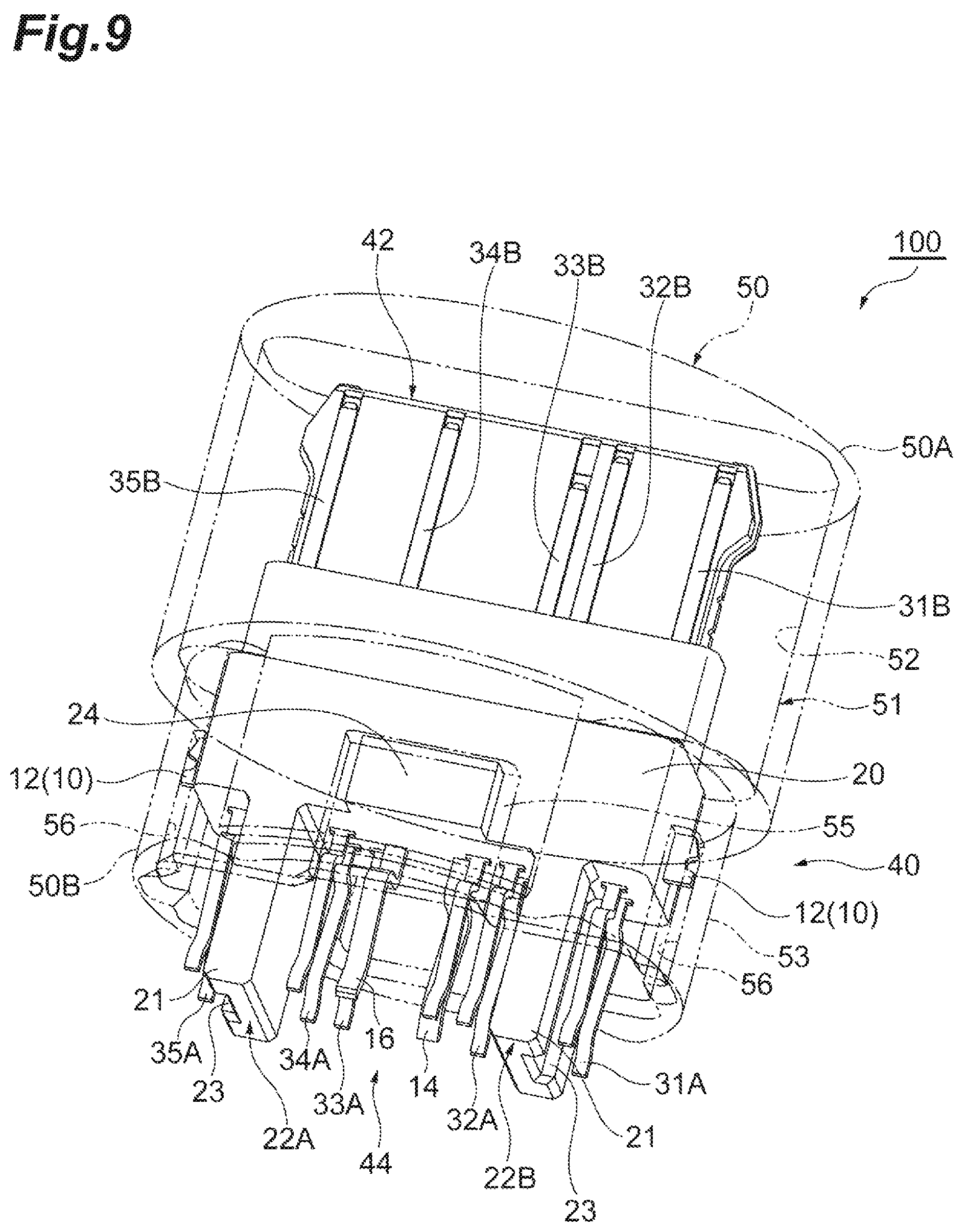
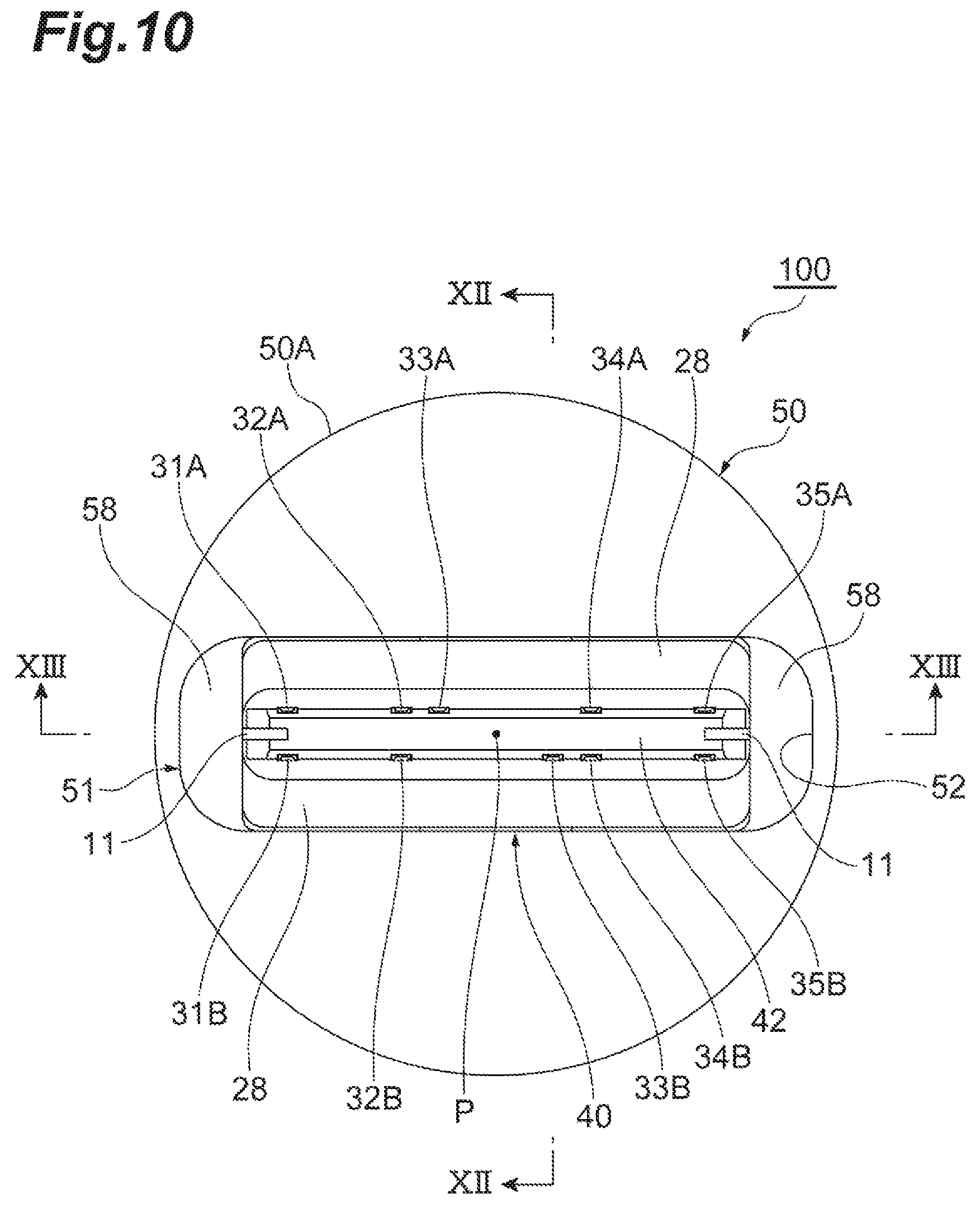
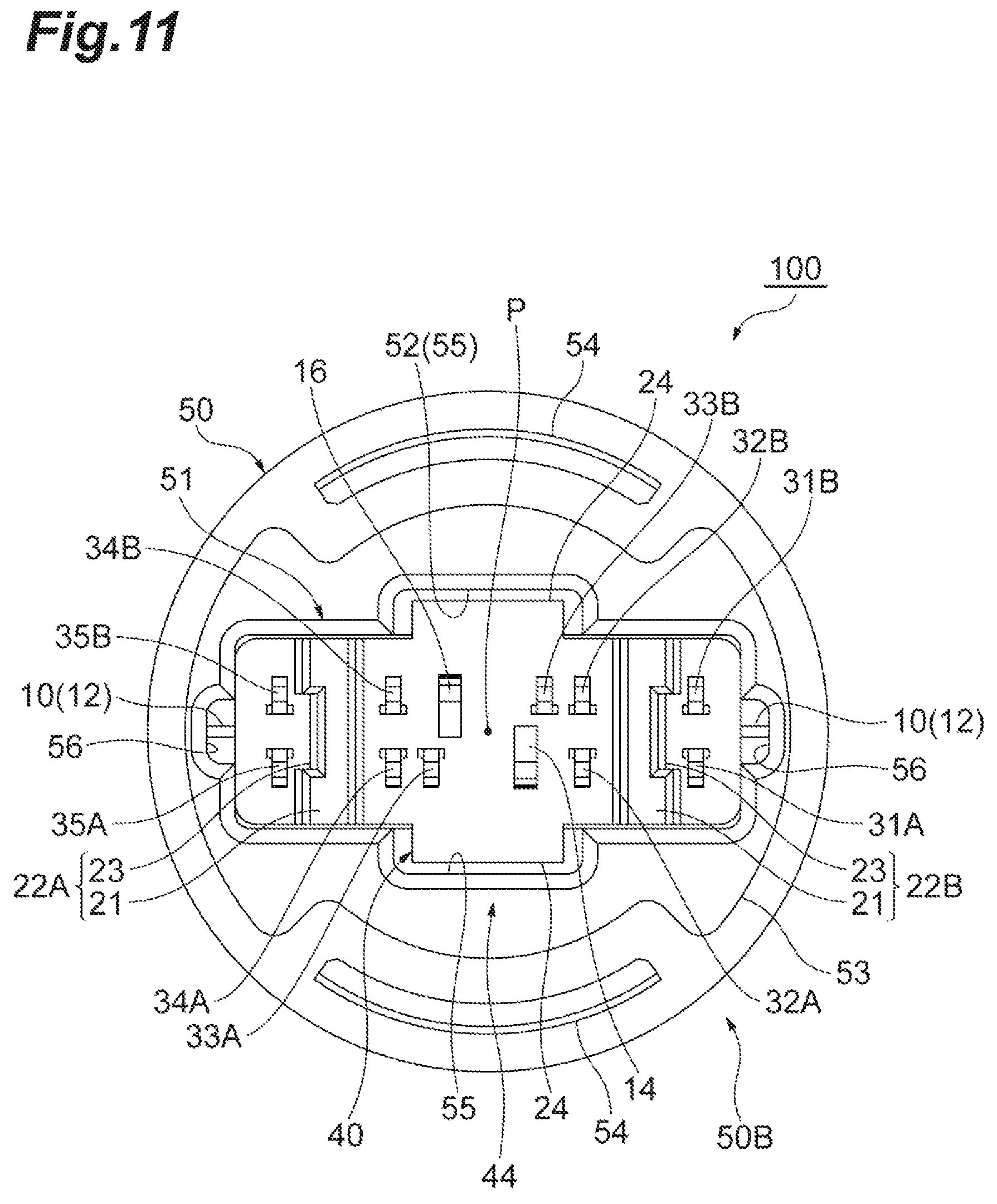
View All Diagrams
| United States Patent | 10,931,065 |
| Hirakawa , et al. | February 23, 2021 |
Connector including plate-shaped conductor and casing with through hole
Abstract
A connector includes a connector main body having a plate-shaped conductor, conductive contacts, and a housing holding the plate-shaped conductor and the conductive contacts so as to remain insulated from each other and a metallic casing forming an exterior of a pen-type electronic device and having a through hole configured such that a mating connector is insertable. The conductive contacts form parts of an electric circuit different from the plate-shaped conductor in the pen-type electronic device. An end portion of the plate-shaped conductor is fixed to an inner wall of the casing forming the through hole such that a distal end portion of the connector main body electrically connected to the mating connector is located in the through hole.
| Inventors: | Hirakawa; Takeshi (Machida, JP), Onoda; Naoto (Kazo, JP) | ||||||||||
|---|---|---|---|---|---|---|---|---|---|---|---|
| Applicant: |
|
||||||||||
| Family ID: | 64104524 | ||||||||||
| Appl. No.: | 16/610,913 | ||||||||||
| Filed: | April 11, 2018 | ||||||||||
| PCT Filed: | April 11, 2018 | ||||||||||
| PCT No.: | PCT/JP2018/015269 | ||||||||||
| 371(c)(1),(2),(4) Date: | November 05, 2019 | ||||||||||
| PCT Pub. No.: | WO2018/207540 | ||||||||||
| PCT Pub. Date: | November 15, 2018 |
Prior Publication Data
| Document Identifier | Publication Date | |
|---|---|---|
| US 20200161812 A1 | May 21, 2020 | |
Foreign Application Priority Data
| May 10, 2017 [JP] | JP2017-094008 | |||
| Current U.S. Class: | 1/1 |
| Current CPC Class: | H01R 12/722 (20130101); H01R 13/6591 (20130101); F21L 4/00 (20130101); H01R 24/60 (20130101); H01R 13/6581 (20130101); H01R 13/6585 (20130101); G06F 3/03 (20130101); H01R 12/55 (20130101); H01R 13/50 (20130101) |
| Current International Class: | H01R 13/648 (20060101); H01R 13/6591 (20110101); H01R 13/6585 (20110101); H01R 13/50 (20060101); H01R 12/55 (20110101) |
| Field of Search: | ;439/607.09 |
References Cited [Referenced By]
U.S. Patent Documents
| 4824383 | April 1989 | Lemke |
| 6190202 | February 2001 | Lai |
| 7094103 | August 2006 | Lai |
| 7175465 | February 2007 | Tsai |
| 7422475 | September 2008 | Hirata |
| 8366485 | February 2013 | Johnescu |
| 9214766 | December 2015 | Yu |
| 9300091 | March 2016 | Katayanagi |
| 9401573 | July 2016 | Fernandez et al. |
| 9666996 | May 2017 | Hsu |
| 9685718 | June 2017 | Wang |
| 9755353 | September 2017 | Tsai |
| 9905944 | February 2018 | Little et al. |
| 9997869 | June 2018 | Zhang |
| 10205290 | February 2019 | Tsai |
| 2005/0215109 | September 2005 | Satou |
| 2013/0090005 | April 2013 | Nesme et al. |
| 2013/0330976 | December 2013 | Simmel et al. |
| 2014/0073190 | March 2014 | Zhao et al. |
| 2015/0270659 | September 2015 | Kao et al. |
| 2015/0303623 | October 2015 | Kao et al. |
| 2016/0013599 | January 2016 | Ueda et al. |
| 2016/0141804 | May 2016 | Kao et al. |
| 2016/0156136 | June 2016 | Kao |
| 2016/0172791 | June 2016 | Fan et al. |
| 2016/0329660 | November 2016 | Xing et al. |
| 2016/0344122 | November 2016 | Kao |
| 2017/0054256 | February 2017 | Yokoyama et al. |
| 2017/0110837 | April 2017 | Taniguchi et al. |
| 2017/0201048 | July 2017 | Kong et al. |
| 2017/0310056 | October 2017 | Yuan et al. |
| 2018/0109042 | April 2018 | Little et al. |
| 2018/0181222 | June 2018 | Ivanov |
| 2018/0331468 | November 2018 | Little et al. |
| 2019/0123470 | April 2019 | Li et al. |
| 2019/0131748 | May 2019 | Cheng |
| 1781347 | May 2006 | CN | |||
| 201522692 | Jul 2010 | CN | |||
| 203521701 | Apr 2014 | CN | |||
| 204179381 | Feb 2015 | CN | |||
| 104466511 | Mar 2015 | CN | |||
| 103779697 | Jul 2016 | CN | |||
| S60-080685 | Jun 1985 | JP | |||
| H3-501185 | Mar 1991 | JP | |||
| H6-054230 | Jul 1994 | JP | |||
| 3070359 | Jul 2000 | JP | |||
| 2003-331958 | Nov 2003 | JP | |||
| 2006-260345 | Sep 2006 | JP | |||
| 2015-228345 | Dec 2015 | JP | |||
| 2016-018674 | Feb 2016 | JP | |||
| 5913759 | Apr 2016 | JP | |||
| 2017-037726 | Feb 2017 | JP | |||
| 200536192 | Nov 2005 | TW | |||
| 201547124 | Dec 2015 | TW | |||
Other References
|
International Search Report dated May 29, 2018 for PCT/JP2018/015269. cited by applicant . International Preliminary Report on Patentability with Written Opinion dated Nov. 12, 2019 for PCT/JP2018/015269. cited by applicant . International Search Report dated Jul. 10, 2018 for PCT/JP2018/015270. cited by applicant . International Preliminary Report on Patentability with Written Opinion dated Nov. 12, 2019 for PCT/JP2018/015270. cited by applicant . Soei Patent and Law Firm, Statement of Related Matters, dated Jan. 27, 2020. cited by applicant. |
Primary Examiner: Riyami; Abdullah A
Assistant Examiner: Imas; Vladimir
Attorney, Agent or Firm: Soei Patent & Law Firm
Claims
The invention claimed is:
1. A connector comprising: a connector main body comprising a plate-shaped conductor, a conductive contact, and a housing holding the plate-shaped conductor and the conductive contact so as to remain insulated from each other; and a metallic casing forming an exterior of a pen-type electronic device and comprising a through hole configured such that a mating connector is insertable, wherein the conductive contact forms a part of an electric circuit different from the plate-shaped conductor in the pen-type electronic device, and wherein an end portion of the plate-shaped conductor is fixed to an inner wall of the casing forming the through hole such that a distal end portion of the connector main body electrically connected to the mating connector is located in the through hole.
2. The connector according to claim 1, wherein the plate-shaped conductor comprises an elastic portion urging the end portion of the plate-shaped conductor toward the inner wall.
3. The connector according to claim 1, wherein a step portion engageable with the end portion of the plate-shaped conductor is formed on the inner wall, and wherein the end portion of the plate-shaped conductor is fixed to the inner wall by abutting against the step portion.
4. The connector according to claim 1, wherein the casing comprises an abutting surface against which a distal end of the mating connector abuts, when the mating connector is connected to the distal end portion of the connector main body.
5. The connector according to claim 1, wherein the conductive contact of the connector main body is located along a surface of the plate-shaped conductor.
6. The connector according to claim 1, wherein the conductive contact extends so as to be exposed from the housing at the distal end portion and a rear end portion of the connector main body and comprises a connection portion electrically connected to a substrate incorporated into the pen-type electronic device at the rear end portion of the connector main body.
7. The connector according to claim 6, further comprising: a positioning portion positioning the connector main body and the substrate relative to each other at the rear end portion of the connector main body, wherein the positioning portion is located closer to a center line of the connector main body than the conductive contact when the connector main body is viewed in plan, the center line extending along a direction from the distal end portion of the connector main body toward the rear end portion.
8. The connector according to claim 7, wherein the positioning portion comprises a projection protruding in the direction beyond the conductive contact and the plate-shaped conductor.
Description
CROSS-REFERENCE TO RELATED APPLICATIONS
This application is a 35 U.S.C. .sctn. 371 national phase application of PCT/JP2018/015269, filed on Apr. 11, 2018, which claims priority to Japanese Patent Application No. 2017-094008, filed on May 10, 2017.
TECHNICAL FIELD
The present disclosure relates to a connector.
BACKGROUND ART
Various devices such as a penlight, a laser pointer, a pen-type recorder, a pen-type demagnetizer, a pen-type hardness tester, a pen-type humidifier, and an electronic pen are known as pen-type electronic devices. A connector may be provided in the devices for the purpose of charging of a built-in battery, communication with a computer device, or the like.
For example, Patent Literature 1 proposes an electronic pen in which a battery is charged by a male USB connector as a mating connector being connected to a female USB connector provided on a cap. A member provided with such a USB connector is usually made of resin and the USB connector is mounted by being embedded in a cured resin.
CITATION LIST
Patent Literature
Patent Literature 1: Japanese Unexamined Patent Publication No. 2006-260345
SUMMARY OF INVENTION
Technical Problem
Pen-type electronic devices are required to have an elongated shape for convenience in terms of function and design. In a case where the main body of a pen-type electronic device is provided with a connector for convenience improvement, it is necessary to increase the thickness of the part where the connector is mounted in order to maintain the mechanical strength of the pen-type electronic device. As a result, it tends to become difficult to maintain the originally required elongated shape. Such a tendency becomes more prominent particularly when the mating connector is enlarged due to fast charging or the like. Desired in this regard is to realize a technique with which the mechanical strength of an elongated pen-type electronic device can be maintained even when the device is provided with a connector.
An object of the present invention is to provide a connector capable of achieving a reduction in outer diameter while maintaining the mechanical strength of a pen-type electronic device.
Solution to Problem
Provided in an aspect of the present disclosure is a connector including a connector main body comprising a plate-shaped conductor, a conductive contact, and a housing holding the plate-shaped conductor and the conductive contact so as to remain insulated from each other and a metallic casing forming an exterior of a pen-type electronic device and comprising a through hole configured such that a mating connector is insertable. The conductive contact forms a part of an electric circuit different from the plate-shaped conductor in the pen-type electronic device. An end portion of the plate-shaped conductor is fixed to an inner wall of the casing forming the through hole such that a distal end portion of the connector main body electrically connected to the mating connector is located in the through hole.
The connector is provided with the metallic casing. The mechanical strength of the metallic casing is higher than the mechanical strength of a resinous casing. The metallic casing has the through hole configured such that the mating connector is insertable. The distal end portion of the connector main body is located in the through hole. Accordingly, the function of the pen-type electronic device can be exhibited by the mating connector and the connector main body being electrically connected to each other. When the connector is disposed such that such a metallic casing serves as the exterior of the pen-type electronic device, it is possible to reduce the outer diameter of the pen-type electronic device without impairing the mechanical strength of the pen-type electronic device.
The end portion of the plate-shaped conductor is fixed to the inner wall of the metallic casing forming the through hole, and thus the casing is capable of functioning as a part of a ground (earth) circuit as well. Accordingly, it is possible to suppress static electricity generation, protect the internal circuit of a substrate incorporated in the pen-type electronic device, and improve the reliability of the pen-type electronic device.
The plate-shaped conductor may be provided with an elastic portion urging the end portion toward the inner wall of the through hole. In this manner, the plate-shaped conductor is satisfactorily fixed to the inner wall of the casing forming the through hole even in an inter-metal member manner and the reliability of the connector can be improved.
A step portion engageable with an end portion of the plate-shaped conductor may be formed on the inner wall. An end portion of the plate-shaped conductor may be fixed to the inner wall by abutting against the step portion. In this manner, the plate-shaped conductor is more firmly fixed to the inner wall of the casing forming the through hole and the reliability of the connector can be further improved.
The metallic casing may have an abutting surface. A distal end of the mating connector abutts against the abutting surface when the mating connector is connected to a distal end portion of the connector main body. By such an abutting surface being provided, the mating connector abuts against the metallic casing when the mating connector is connected to the connector. In this manner, it is possible to suppress breakage of the connector main body attributable to an excessive insertion force during mating connector connection and the connection reliability of the connector can be improved.
The conductive contacts of the connector main body may be located along a surface and a back surface of the plate-shaped conductor. In this case, signal interference between the conductive contacts located along the surface and the back surface, so-called crosstalk, can be suppressed by the plate-shaped conductor. Application to a highly versatile connector such as a USB Type C connector is also possible by the connector main body being configured as described above. However, the type of the connector is not limited thereto.
The conductive contact may extend so as to be exposed from the housing at distal and rear end portions of the connector main body and may have a connection portion electrically connected to a substrate incorporated into the pen-type electronic device at the rear end portion of the connector main body. With such a connector, substrate connection can be simplified and the efficiency of pen-type electronic device manufacturing can be improved.
In the connector, a positioning portion positioning the connector main body and the substrate relative to each other may be provided at the rear end portion of the connector main body. The positioning portion may be located closer to a center line of the connector main body than at least one of the conductive contacts when the connector main body is viewed in plan. The center line extends along a direction from the distal end portion of the connector main body toward the rear end portion. By such a positioning portion being provided, the connector main body can be reduced in size as compared with a case where the positioning portion is provided at a position farther from the center line than every conductive contact. Accordingly, the outer diameter of the pen-type electronic device can be sufficiently small. In addition, the substrate can be smoothly positioned.
The positioning portion may have a projection protruding in the direction from the distal end portion of the connector main body toward the rear end portion beyond the conductive contact and the plate-shaped conductor. In this manner, the positioning portion comes into contact with the substrate before the conductive contact and the plate-shaped conductor come into contact with the substrate when the substrate is connected to the connector main body. Accordingly, it is possible to suppress deformation or the like of the conductive contact and the plate-shaped conductor.
The connector described above may further include a substrate connected to the rear end portion of the connector main body. In this case, a terminal of the substrate is electrically connected to the conductive contact and the substrate is incorporated into the pen-type electronic device. Such a connector has an integrated structure with the substrate, and thus methods for manufacturing pen-type electronic devices provided with the connector can be simplified.
Advantageous Effects of Invention
Provided is a connector capable of achieving a reduction in outer diameter while maintaining the mechanical strength of a pen-type electronic device.
BRIEF DESCRIPTION OF DRAWINGS
FIG. 1 is a perspective view of a connector according to an embodiment.
FIG. 2 is a perspective view in which a connector main body provided in the connector according to an embodiment is viewed from a front surface side.
FIG. 3 is a perspective view in which the connector main body provided in the connector according to an embodiment is viewed from a rear surface side.
FIG. 4 is a plan view of the connector main body provided in the connector according to an embodiment.
FIG. 5 is a front view of the connector main body provided in the connector according to an embodiment.
FIG. 6 is a cross-sectional view of the connector main body taken along line VI-VI in FIG. 5.
FIG. 7 is a cross-sectional view of the connector main body taken along line VII-VII in FIG. 5.
FIG. 8 is a perspective view in which a casing provided in the connector according to an embodiment is viewed from the rear surface side.
FIG. 9 is a diagram illustrating the connector main body that is fixed to the casing in the connector according to an embodiment.
FIG. 10 is a front view of the connector according to an embodiment.
FIG. 11 is a rear view of the connector according to an embodiment.
FIG. 12 is a cross-sectional view taken along line XII-XII in FIG. 10.
FIG. 13 is a cross-sectional view taken along line XIII-XIII in FIG. 10.
FIG. 14 is a cross-sectional view taken along line XIV-XIV in FIG. 13.
FIG. 15 is a diagram illustrating a process of attaching a substrate to the connector according to an embodiment.
FIG. 16 is a perspective view of a connector according to another embodiment.
FIG. 17 is a diagram illustrating the structure of a pen-type electronic device.
FIG. 18 is a diagram illustrating the connection structure in the upper end portion of the pen-type electronic device in FIG. 17.
FIG. 19 is a diagram describing connection between a mating connector and a connector provided in the pen-type electronic device.
DESCRIPTION OF EMBODIMENTS
Hereinafter, embodiments will be described with reference to the drawings as the case may be. However, the following embodiments are examples and are not intended to limit the present invention to the following content. In the description, the same reference numerals will be used for the same elements or elements having the same functions and redundant descriptions will be omitted if the omission is necessary. Unless otherwise specified, positional relationships such as up, down, left, and right are based on the positional relationships illustrated in the drawings. The dimensional ratios of each element are not limited to the illustrated ratios.
In several embodiments, the connector of the present disclosure is provided with a connector main body and a metallic casing. The connector main body is provided with a connector main body provided with a plate-shaped conductor, conductive contacts (hereinafter, referred to as the conductive contacts), and a housing holding the plate-shaped conductor and the conductive contacts so as to remain insulated from each other. The casing has a through hole configured such that a mating connector is insertable. An end portion of the plate-shaped conductor is fixed to an inner wall of the casing forming the through hole such that a distal end portion of the connector main body electrically connected to the mating connector is located in the through hole. The casing may be, for example, a metal containing at least one selected from copper, aluminum, nickel, tin, and cobalt or may be an alloy containing these metals. For example, the casing may be alloy steel such as stainless steel.
The metallic casing forms the exterior of a pen-type electronic device. In other words, the connector is used in a pen-type electronic device. Examples of the pen-type electronic device include a penlight, a laser pointer, a pen-type recorder, a pen-type demagnetizer, a pen-type hardness tester, a pen-type humidifier, and an electronic pen. However, the pen-type electronic device is not limited thereto. The connector is provided with the metallic casing, and thus is superior in mechanical strength to resinous connectors. Accordingly, it is possible to reduce the outer diameter of the connector without impairing the mechanical strength of the connector. Accordingly, the connector can be used for various substantially pen-shaped electronic devices other than those described above.
A conductor such as a copper alloy forms the conductive contact and the plate-shaped conductor. The conductive contact extends between the distal and rear end portions of the connector main body. When the connector is attached to a pen-type electronic device, the conductive contact functions as a conductive contact for signal transmission, electric power supply, ground, or the like. In this manner, the conductive contact forms a part of an electric circuit different from the plate-shaped conductor in the pen-type electronic device. The plate-shaped conductor forms a part of a ground circuit or the like in the pen-type electronic device. The plate-shaped conductor may have a plate-shaped main portion. The plate-shaped conductor may have a member (such as a tongue-shaped portion) extending from the plate-shaped main portion. An insulating cured resin or the like forms the housing.
In a case where the connector is connected to a mating connector, the connector may be a so-called female connector (receptacle connector) and coupled to the mating connector that is a male connector (plug connector). The type of the connector is not particularly limited. In several embodiments, the connector may be, for example, a receptacle connector conforming to the Universal Serial Bus (USB) Type-C standard.
FIG. 1 is a perspective view of a connector 100 according to an embodiment. The connector 100 is provided with a metallic casing 50 having a through hole 51 into which a mating connector is inserted and a connector main body 40 fixed to an inner wall 52 of the casing 50 forming the through hole 51 such that a distal end portion 42 is located in the through hole 51. The casing 50 (shell 50) has a main body portion 50A having a substantially columnar outer shape and a connecting portion 50B for attaching the connector 100 to the pen main body portion of a pen-type electronic device. In the description of the present disclosure, a surface 50a side of the main body portion 50A, which is in front of the connecting portion 50B, will be referred to as the front surface side of the connector 100 and the connecting portion side will be referred to as the rear surface side of the connector 100 with the distal end portion 42 of the connector main body 40 in FIG. 1 viewed from the front surface such that the connecting portion 50B is at the rear.
FIG. 2 is a perspective view in which the connector main body 40 is viewed from the front surface side. The connector main body 40 is provided with a plate-shaped conductor 10 having a main body portion embedded in a housing 20, conductive contacts 31A, 32A, 33A, 34A, and 35A (hereinafter, collectively referred to as "31A to 35A"), and the housing 20 holding the plate-shaped conductor 10 and the conductive contacts 31A to 35A so as to remain insulated from each other. The conductive contacts 31A to 35A function as conductive contacts for signal transmission, electric power supply, ground, or the like when the connector 100 is attached to the pen-type electronic device.
The conductive contacts 31A to 35A are exposed in the distal end portion 42 of the connector main body 40 so as to be capable of being in contact with conductive contacts of the mating connector when the connector 100 is connected to the mating connector. In addition, the conductive contacts 31A to 35A are exposed in a rear end portion 44 of the connector main body 40 so as to be capable of being in contact with terminals provided on a substrate 70 (see FIGS. 15 and 16) attached to the rear end portion 44 located on the rear surface side of the connector main body 40. In this manner, the conductive contacts 31A to 35A extend between the distal end portion 42 and the rear end portion 44. The middle portions of the conductive contacts 31A to 35A are held so as to remain insulated from the casing 50 as well by being embedded in the cured resin that forms the housing 20.
The housing 20 has a projecting portion 24 protruding upward in FIG. 2. When the connector main body 40 is fixed to the casing 50, the projecting portion 24 regulates the depth of insertion of the connector main body 40 into the through hole 51 by abutting against a recess 55 (see FIG. 8) formed in the through hole 51 of the casing 50. In this manner, the projecting portion 24 functions as a fixing portion of the connector main body 40 with respect to the casing 50 together with an end portion 12 of the plate-shaped conductor 10. However, the projecting portion 24 is optional and simply the pair of end portions 12 at both ends of the connector main body 40 may function as fixing portions of the connector main body 40 with respect to the casing 50.
FIG. 3 is a perspective view in which the connector main body 40 is viewed from the rear surface side. The back surface of the connector main body 40 is illustrated in FIG. 3 whereas the surface of the connector main body 40 is illustrated in FIG. 2. As illustrated in FIG. 3, also on the back surface of the connector main body 40, conductive contacts 31B, 32B, 33B, 34B, and 35B (hereinafter, collectively referred to as "31B to 35B") extend between the distal end portion 42 and the rear end portion 44 similarly to the conductive contacts 31A to 35A provided on the surface. As illustrated in FIG. 5, the conductive contacts 31A, 32A, 34A, and 35A illustrated in FIG. 2 and the conductive contacts 31B, 32B, 34B, and 35B illustrated in FIG. 3 are located so as to face each other via the plate-shaped conductor 10, respectively.
As illustrated in FIG. 6, the conductive contacts 31A to 35A and the conductive contacts 31B to 35B are curved in the rear end portion 44. Specifically, the conductive contacts 31A to 35A and the conductive contacts 31B to 35B are curved such that the gap between the conductive contacts located so as to face each other is larger in the rear end portion 44 than in the distal end portion 42 of the connector main body 40. In the rear end portion 44, a substrate is attached between the conductive contacts 31A to 35A and the conductive contacts 31B to 35B. Incidentally, the shape of each conductive contact is not limited thereto. The gap between the conductive contacts located so as to face each other may be constant or may be smaller in the rear end portion 44 than in the distal end portion 42 of the connector main body 40.
As illustrated in FIGS. 2 and 3, the end portions 12 of the plate-shaped conductor 10 are respectively exposed from the housing 20 in both side portions of the connector main body 40. In addition, a side edge portion 11 of the plate-shaped conductor 10 is exposed in the distal end portion 42 of the connector main body 40 and an end portion 46 on the front surface side continuous from the distal end portion 42. Further, the plate-shaped conductor 10 has tongue-shaped portions 14 and 16 exposed in the rear end portion 44 of the connector main body 40. The other parts of the plate-shaped conductor 10 are embedded in the housing 20.
As illustrated in FIG. 11, the tongue-shaped portion 14 of the plate-shaped conductor 10 is provided between the conductive contact 32A and the conductive contact 33A so as to substantially face the conductive contact 33B in the rear end portion 44. The tongue-shaped portion 16 of the plate-shaped conductor 10 is provided between the conductive contact 33B and the conductive contact 34B so as to substantially face the conductive contact 33A in the rear end portion 44. The tongue-shaped portions 14 and 16 are respectively in contact with terminals provided on the surface and the back surface of a substrate and function as, for example, parts of a ground circuit.
As illustrated in FIG. 3, the housing 20 is provided with a positioning portion 22A having a projection 21 protruding in the direction from the distal end portion 42 toward the rear end portion 44 so as to partition the conductive contacts 34A and 34B and the conductive contacts 35A and 35B from each other in the rear end portion 44. The positioning portion 22A is capable of sufficiently suppressing the occurrence of a short circuit between the conductive contact 34A (34B) and the conductive contact 35A (35B) or the like as well.
The housing 20 is provided with a positioning portion 22B having the projection 21 protruding in the direction from the distal end portion 42 toward the rear end portion 44 so as to partition the conductive contacts 31A and 31B and the conductive contacts 32A and 32B from each other. The positioning portion 22B is capable of sufficiently suppressing the occurrence of a short circuit between the conductive contact 31A (31B) and the conductive contact 32A (32B) or the like as well.
The positioning portions 22A and 22B are provided closer to the middle (inside) than the pair of conductive contacts 31A (31B) and 35A (35B), which have the most lateral (outermost) disposition in the connector main body 40 among the conductive contacts 31A to 35A and 31B to 35B. Accordingly, the connector main body 40 and the connector 100 can be smaller than in a case where the positioning portions are provided more laterally (outside) than the pair of conductive contacts 31A (31B) and 35A (35B). Accordingly, the connector 100 can be more suitably used as a connector for a pen-type electronic device that is required to be reduced in outer diameter.
As illustrated in FIG. 3, the positioning portions 22A and 22B have groove portions 23, which are engaged with a substrate, in addition to the projections 21. The groove portions 23 are provided in the surfaces of the projections 21 that are opposite to the surfaces of the projections 21 facing each other. By the projection 21 having the groove portion 23, the accuracy of substrate positioning can be further increased. Incidentally, in several other embodiments, the projections 21 may have the groove portions 23 in the surfaces of the projections 21 that face each other or may have the groove portions 23 in both the surfaces of the projections 21 that face each other and the surfaces opposite to the surfaces.
As illustrated in FIG. 3, the housing 20 has the upwardly protruding projecting portion 24 on the back surface as well. In this manner, the housing 20 has a symmetrical shape on the surface and the back surface of the connector main body 40. However, the shape of the housing 20 is not limited to the shape symmetrical on the surface and the back surface. For example, the projecting portion 24 may be formed on only one of the surface and the back surface of the connector main body 40.
FIG. 4 is a plan view of the connector main body 40. In other words, FIG. 4 is a diagram in which the back side of the connector main body 40 (upper surface in FIG. 3) is viewed in plan. As illustrated in FIG. 4, the conductive contacts 31B and 35B are provided farther from a center line CL of the connector main body 40 than the positioning portions 22A and 22B. In other words, the positioning portions 22A and 22B are provided closer to the center line CL of the connector main body 40 than the conductive contacts 31B and 35B, respectively. Here, the center line CL is a straight line extending along the direction from the distal end portion 42 toward the rear end portion 44. It can also be said that the center line CL is a straight line extending along the direction in which the mating connector is inserted. The center line CL extends in parallel to the longitudinal direction (direction of extension) of the conductive contacts 31B to 35B (31A to 35A).
Although the positional relationship between the positioning portions 22A and 22B and the conductive contacts 31B and 35B has been described with reference to FIG. 4, the positioning portions 22A and 22B and the conductive contacts 31A and 35A have a positional relationship similar to the positional relationship between the positioning portions 22A and 22B and the conductive contacts 31B and 35B also on the front side of the connector main body 40. Although the housing 20 has the two positioning portions 22A and 22B in the present embodiment, the present disclosure is not limited thereto. For example, the connector main body 40 may have one positioning portion located near the middle of the rear end portion 44 so as to overlap the center line CL. Alternatively, the connector main body 40 may have three or more positioning portions between the conductive contact 31A (31B) and the conductive contact 35B (35B). Incidentally, in another embodiment, the connector main body 40 may further have another positioning portion at a position farther from the center line CL than the conductive contact 31A (31B) and the conductive contact 35B (35B). However, from the viewpoint of reducing the size of the connector 100, it is preferable not to have such an additional positioning portion.
FIG. 5 is a front view of the connector main body 40. In other words, FIG. 5 is a diagram in which the connector main body 40 is viewed from the distal end portion 42 toward the rear end portion 44. The upper part of FIG. 5 corresponds to the surface of the connector main body 40 and the lower part of FIG. 5 corresponds to the back surface of the connector main body 40. The side edge portion 11 of the plate-shaped conductor 10 is exposed in the end portion on the front surface side and the distal end portion 42 of the connector main body 40 and the end portion 12 is exposed so as to protrude sideways from the housing 20 in both side portions of the connector main body 40.
FIG. 6 is a cross-sectional view of the connector main body 40 taken along line VI-VI in FIG. 5. The plate-shaped conductor 10 is embedded in a substantially middle portion of the housing 20 in the direction in which the conductive contact 34A and the conductive contact 34B face each other. The plate-shaped conductor 10 and the conductive contacts 34A and 34B are separated by the cured resin that forms the housing 20. The other conductive contacts are also separated from the plate-shaped conductor 10 by the cured resin that forms the housing 20. The conductive contacts 34A and 34B are formed so as to be vertically symmetrical with respect to the plate-shaped conductor 10 embedded in the housing 20. The conductive contact 34A is located along a surface 10A of the plate-shaped conductor 10 and the conductive contact 34B is located along a back surface 10B. The other conductive contacts are similarly located along the surface 10A and the back surface 10B of the plate-shaped conductor 10. Signal interference between the conductive contacts located along the surface 10A and the back surface 10B, so-called crosstalk, can be suppressed by the plate-shaped conductor 10.
FIG. 7 is a cross-sectional view of the connector main body 40 taken along line VII-VII in FIG. 5. The plate-shaped conductor 10 has the side edge portion 11 exposed in the end portion on the front surface side and the distal end portion 42 of the connector main body 40, the end portion 12 exposed from the housing 20 in the side portion of the connector main body 40, a main body portion 10a embedded in the housing 20, and the tongue-shaped portions 14 and 16 exposed from the housing 20 in the rear end portion 44 of the connector main body 40. A plurality of through holes 10b are formed so as to be dotted in the main body portion 10a. The main body portion 10a has notch portions 10c at locations corresponding to the vicinity of the proximal end of the positioning portion 22A and the vicinity of the proximal end of the positioning portion 22B.
An elastic portion 13 (connecting portion) between the end portion 12 and the main body portion 10a has a bridge shape by the notch portions 10c and 10c being formed between the pair of end portions 12. Accordingly, when a force in the facing direction of the pair of end portions 12 acts on the pair of end portions 12, the bridge-shaped elastic portions 13 are elastically deformed while biting into the cured resin in the notch portion 10c and the bridge-shaped elastic portions 13 respectively move in the facing direction. In this case, the elastic portions 13 urge the pair of end portions 12 in the direction opposite to the facing direction with a stress commensurate with the amount of deformation resulting from the movement.
FIG. 8 is a perspective view in which the casing 50 is viewed from the rear surface side. The casing 50 has a pair of circular arc-shaped locking portions 54 formed in the connecting portion 50B and along the outer peripheral surface of the main body portion 50A and located so as to face each other and a protruding portion 53 provided between the pair of locking portions 54 and having the through hole 51 communicating with the main body portion 50A.
A pair of the recesses 55 are formed in the inner wall 52 of the casing 50 forming the through hole 51 so as to face each other in the vertical direction in FIG. 8. When the connector main body 40 is fixed to the casing 50, the recess 55 abuts against the projecting portion 24 of the connector main body 40. As a result, it is possible to regulate an excessive movement of the connector main body 40 in the depth direction in FIG. 8 with respect to the through hole 51 of the casing 50.
A pair of step portions 56 are formed in the inner wall 52 of the casing 50 forming the through hole 51 so as to face each other in the left-right direction in FIG. 8. The step portion 56 is formed in a groove shape in the inner wall 52 so as to be engageable with the end portion 12 of the plate-shaped conductor 10. The shape of the step portion 56 is not limited thereto. In another embodiment, the step portions 56 may take the form of projections vertically sandwiching the end portion 12 of the plate-shaped conductor 10.
FIG. 9 is a diagram illustrating the connector main body 40 that is fixed to the casing 50 in the connector 100. In FIG. 9, the casing 50 is indicated by a two-dot chain line and the connector main body 40 is indicated by a solid line so that understanding of the state where the connector main body 40 is fixed to the casing 50 is facilitated. FIG. 10 is a front view of the connector 100 and FIG. 11 is a rear view of the connector 100.
As illustrated in FIGS. 9 and 11, the end portion 12 of the plate-shaped conductor 10 in the connector main body 40 is locked to the groove-shaped step portion 56. As a result, the distal end portion 42 of the connector main body 40 electrically connected to the mating connector inserted into the through hole 51 is located in the through hole 51.
The end portion 12 of the plate-shaped conductor 10 abuts against the inner wall 52 of the metallic casing 50, and thus the casing 50 is capable of functioning as a part of a ground (earth) circuit. Accordingly, it is possible to suppress static electricity generation, protect the internal circuit of the substrate incorporated in the pen-type electronic device, and improve the reliability of the pen-type electronic device.
The means for fixing the end portion 12 of the plate-shaped conductor to the inner wall 52 is not limited to the above. For example, in several other embodiments, the end portion 12 may be fixed to the inner wall 52 by the end portion 12 and the step portion 56 being joined by soldering or welding.
As illustrated in FIG. 9, the positioning portions 22A and 22B are provided with the projections 21. The projections 21 protrude in the direction from the distal end portion 42 of the connector main body 40 toward the rear end portion 44 beyond the conductive contacts 31A to 35A and 31B to 35B and the plate-shaped conductor 10 (tongue-shaped portions 14 and 16). Accordingly, when a substrate is connected to the rear end portion 44 of the connector main body 40, the positioning portions 22A and 22B (projections 21) come into contact with the substrate before the conductive contacts 31A to 35A and 31B to 35B and the tongue-shaped portions 14 and 16 of the plate-shaped conductor 10 come into contact with the substrate. Accordingly, it is possible to suppress, for example, deformation and breakage of the conductive contacts 31A to 35A and 31B to 35B and the tongue-shaped portions 14 and 16 of the plate-shaped conductor 10.
As illustrated in FIG. 10, the inner wall 52 using the through hole 51 of the casing 50 has an abutting surface 58 standing on the inner wall 52. When the mating connector is inserted in the through hole 51 of the casing 50 of the connector 100 and connected to the distal end portion 42 of the connector main body 40, the distal end of the mating connector abuts against the metallic abutting surface 58 and front walls 28 and 28 of the connector main body 40, which are formed along the respective contact arrangement directions of the conductive contacts 31A to 35A on the surface and the conductive contacts 31B to 35B on the back surface. The depth of insertion of the mating connector into the through hole 51 is regulated by the distal end of the mating connector abutting against the abutting surface 58 and the front wall 28 as described above.
The distal end of the mating connector abuts against the metallic abutting surface 58 as well as the front wall 28 of the connector main body 40. The connector 100 has the metallic abutting surface 58, and thus it is possible to suppress breakage attributable to an excessive insertion force during mating connector connection. Accordingly, the connection reliability of the connector 100 can be improved.
When the connector 100 is viewed from the front surface side of the connector main body 40 as in FIG. 10, the conductive contacts 31A to 35A provided along the surface 10A (see FIG. 6) of the plate-shaped conductor 10 and the conductive contacts 31B to 35B provided along the back surface 10B are located such that a central axis P of the connector 100 is the center of symmetry. Accordingly, the connector 100 can also be used as a highly versatile connector such as a USB Type-C connector usable on both the surface and the back surface of the connector.
FIG. 12 is a cross-sectional view taken along line XII-XII in FIG. 10. FIG. 13 is a cross-sectional view taken along line XIII-XIII in FIG. 10. As illustrated in FIG. 12, in the connector 100, the projecting portion 24 of the connector main body 40 abuts against the recess 55 formed in the through hole 51 of the casing 50. The abutting surface 58 formed in the through hole 51 of the casing 50 illustrated in FIG. 13 becomes a surface of contact with the distal end portion of the mating connector together with the front wall 28 of the connector main body 40 illustrated in FIG. 12.
As illustrated in FIG. 13, the end portion 12 of the plate-shaped conductor 10 is fixed to the step portion 56 of the casing 50. As a result, the end portion 12 is satisfactorily fixed to the inner wall 52 of the casing 50 forming the though hole 51 and the reliability of the connector 100 can be improved. The gap between the pair of end portions 12 in the plate-shaped conductor 10 may be smaller than the gap prior to attachment of the connector main body 40 to the casing 50 by elastic deformation of the elastic portion 13 configured as a bridge portion. In this case, the end portions 12 are urged toward the step portion 56 by the stress that is generated with the elastic deformation of the elastic portion 13. As a result, the end portions 12 are better fixed to the inner wall 52 of the casing 50 forming the through hole 51. Accordingly, the reliability of the connector 100 can be further improved even during inter-metal member fixing.
The connection between the casing 50 and the connector main body 40 may be reinforced by means of an adhesive, solder, or the like. For example, the contact surface between the recess 55 and the projecting portion 24 may be fixed by means of an adhesive and the end portion 12 of the plate-shaped conductor 10 and the step portion 56 of the casing 50 may be fixed by means of solder.
FIG. 14 is a cross-sectional view taken along line XIV-XIV in FIG. 13. In other words, FIG. 14 is an enlarged partial cross-sectional view illustrating the vicinity of the abutting part between the end portion 12 of the plate-shaped conductor 10 and the step portion 56 of the though hole 51. A reaction force F1 from the step portion 56 acts on the end portion 12 as illustrated in FIG. 14 when the end portion 12 of the plate-shaped conductor 10 urges the step portion 56 by the stress that results from elastic deformation of the elastic portion 13 illustrated in FIG. 13.
When the reaction force F1 acts, the notch portion 10c of the plate-shaped conductor 10 bites into the housing 20 along the arrow F2 direction. Here, the plate-shaped conductor 10 has a tapered portion 12a at the outer edge that forms the notch portion 10c and the thickness of the tapered portion 12a decreases toward the central axis P. Accordingly, the plate-shaped conductor 10 (notch portion 10c) is capable of biting into the housing 20 with ease. As a result, the notch portion 10c is locked to the housing 20 and rattling of the end portion 12 can be suppressed. Accordingly, the connector main body 40 can be fixed to the casing 50 with sufficient firmness.
FIG. 15 is a diagram illustrating a process of attaching the substrate 70 to the connector 100. The substrate 70, which is incorporated into the pen-type electronic device, has terminals 71 to 75 on one surface of the substrate 70. The terminals 71 to 75 are electrically connected to the conductive contacts 31B to 35B of the connector 100. In addition, the substrate 70 has a terminal 76 on that surface and the terminal 76 is electrically connected to the tongue-shaped portion 16 of the connector 100. The substrate 70 has terminals electrically connected to the conductive contacts 31A to 35A and the tongue-shaped portion 14 on the other surface as well similarly to that surface. The substrate 70 has notch portions 78 and 78 with which the positioning portions 22A and 22B of the connector 100 are respectively engaged.
In a case where the substrate 70 is attached to the connector 100, the notch portion 78 and the positioning portions 22A and 22B are aligned first. Then, the substrate 70 is brought close to the connector 100 and the projections 21 of the positioning portions 22A and 22B are inserted into the notch portion 78. Then, the distal end of the projection 21 of the connector 100 is allowed to abut against the bottom portion of the notch portion 78. Obtained as a result is a connector 110 having the substrate 70 as illustrated in FIG. 16.
As illustrated in FIG. 15, the projections 21 of the positioning portions 22A and 22B protrude in the direction from the distal end portion 42 of the connector main body 40 toward the rear end portion 44 beyond the conductive contacts 31A to 35A and 31B to 35B and the tongue-shaped portions 14 and 16. Accordingly, when the substrate 70 is attached to the connector 100, the projection 21 comes into contact with the substrate 70 first. Accordingly, it is possible to suppress the substrate 70 coming into contact with the conductive contacts 31A to 35A and 31B to 35B and the tongue-shaped portions 14 and 16 before corning into contact with the projection 21. Accordingly, deformation, breakage, and the like of the members can be suppressed.
The positioning portions 22A and 22B also have the function of guiding the connection between the connector 100 and the substrate 70. The relative positional relationship between the connector main body 40 (connector 100) and the substrate 70 is determined by the positioning portions 22A and 22B having the projection 21. Further, the projection 21 has the groove portion 23 as illustrated in FIG. 9. The notch portion 78 of the substrate 70 and the groove portion 23 are engaged with each other by fitting of the notch portion 78 of the substrate 70 into the groove portion 23. As a result, it is possible to suppress misalignment of the substrate 70 with respect to the connector 100 in the direction in which the conductive contacts 31A to 35A and the conductive contacts 31B to 35B face each other. Accordingly, the positioning accuracy of the connector 100 and the substrate 70 can be further improved. In addition, it is possible to suppress deformation of each of the conductive contacts 31A to 35A and 31B to 35B attributable to misalignment and rattling of the substrate 70 in the same direction.
FIG. 16 is a perspective view of the connector 110 according to another embodiment. The connector 110 is provided with the connector 100 and the substrate 70 connected to the rear end portion 44 of the connector main body 40. A device provided with such a substrate is referred to as a connector device in some cases. The terminals 71 to 75 and the terminal 76 on one surface side of the substrate 70 are electrically connected to the conductive contacts 31B to 35B and the tongue-shaped portion 16 of the plate-shaped conductor 10 respectively exposed from the housing 20 in the rear end portion 44 of the connector main body 40. The connector 110 (connector device 110) is a structure integrated with the substrate 70, and thus pen-type electronic device manufacturing processes can be simplified with the connector 110 (connector device 110). Incidentally, the terminals on the other surface side of the substrate 70 are electrically connected to the conductive contacts 31A to 35A and the tongue-shaped portion 14 as is the case with the one surface side.
As illustrated in FIG. 16, the conductive contact 31B on the back surface of the connector main body 40 in the connector 100 has a connection portion 31a, which comes into contact with the terminal 71 of the substrate 70. Likewise, the other conductive contacts 32B to 35B and the tongue-shaped portion 16 have connection portions respectively coming into contact with the terminals 72 to 75 and the terminal 76 of the substrate 70. The conductive contacts 31B to 35B and the tongue-shaped portion 16 and the terminals 71 to 76 are electrically interconnected by such connection portions. Although not illustrated in FIG. 16, the conductive contacts 31A to 35A and the tongue-shaped portion 14 on the surface of the connector main body 40 similarly have connection portions respectively coming into contact with the terminals 71 to 75 and the terminal 76 of the substrate 70. The manufacturing efficiency of a pen-type electronic device 150 (FIG. 17) can be improved by such connection portions being provided. The tongue-shaped portions 14 and 16 are electrically connected to the terminal 76 of the substrate 70 and function as parts of a ground circuit or the like. The conductive contacts 31A to 35A and the conductive contacts 31B to 35B are connected to the terminals 71 to 75 of the substrate 70 and function as conductive contacts for signal transmission, electric power supply, ground, or the like.
FIG. 17 is a diagram illustrating the structure of the pen-type electronic device 150 provided with the connector 100 to which the substrate 70 is connected, that is, the connector 110. The pen-type electronic device 150 is provided with a cylindrical pen main body portion 80 forming the exterior of the pen-type electronic device 150. The connector 100 (connector 110) is attached to the upper end of the pen main body portion 80. The casing 50 of the connector 100 (connector 110) forms the exterior of the pen-type electronic device 150 together with the pen main body portion 80.
In the pen main body portion 80, a circuit portion 84, a battery 82, and the substrate 70 are accommodated in this order from the nib and in a straight line. The substrate 70 is connected to the connector 100 at one end. At the other end, the substrate 70 is connected to cables 86, 87, and 88 for electrically interconnecting the substrate 70 and the battery 82 or the substrate 70 and the circuit portion 84.
Examples of the circuit portion 84 include circuit portions provided with a printed wiring board, a connection terminal, various integrated circuits, and an electronic component. Specifically, the examples include a control unit controlling each member, a memory storing information, and a communication module. The battery 82 is preferably a rechargeable battery. Examples of the battery 82 include lithium-ion and nickel-hydrogen batteries. The conductive contacts 31A to 35A and 31B to 35B (FIG. 9) of the connector 100 form an electric circuit in the pen-type electronic device 150 together with the substrate 70, the cables 86, 87, and 88, the battery 82, and the circuit portion 84. In the pen-type electronic device 150, the plate-shaped conductor 10 (FIG. 12) forms a ground circuit different from the electric circuit together with the casing 50.
The configurations in the pen main body portion 80 are not limited to the above description and any member other than the above-described members may be accommodated. Examples of the member include a writing pressure sensor detecting pressure applied to the nib, a vibrator vibrating when turned on, and an optical module.
FIG. 18 is a diagram illustrating the connection structure in the upper end portion of the pen-type electronic device 150 in FIG. 17. The cables 86, 87, and 88 are connected to three terminals 77, which are provided on the side of the substrate 70 that is opposite to the terminal on the connector 100 side. The connector 100 is electrically connected to the battery 82 and the circuit portion 84 via the cables 86, 87, and 88 and the substrate 70. The connector 100 is attached to the pen main body portion 80 by the connecting portion 50B being inserted into the upper end of the pen main body portion 80. In this manner, the connecting portion 50B is accommodated in the pen main body portion 80 and the main body portion 50A of the casing 50 forms the outer shape of the pen-type electronic device 150 integrally with the pen main body portion 80.
The locking portion 54 in the connecting portion 50B may be a leaf spring or the like. In this case, it is possible to fix the connector 100 to the pen main body portion 80 by attaching the connector 100 to the pen main body portion 80 such that the locking portion 54 urges the hollow wall of the pen main body portion 80. In another example, the locking portion 54 and the pen main body portion 80 may be fixed by means of an adhesive.
FIG. 19 is a diagram describing connection between a mating connector 200 and the connector 100 provided in the pen-type electronic device 150. The mating connector 200 is provided with an insertion portion 210 on one end side and the insertion portion 210 is inserted into the through hole 51 in the casing 50 of the connector 100. The other end side of the mating connector 200 is connected to, for example, an AC power source or an information device such as a personal computer.
The distal end portion 42 of the connector main body 40 and the insertion portion 210 are electrically connected to each other by the insertion portion 210 of the mating connector 200 being inserted into the through hole 51. As a result, the pen-type electronic device 150 can be charged or signal transmission and reception can be performed between the pen-type electronic device 150 and an external information device. At this time, the distal end of the mating connector 200 abuts against the abutting surface 58 formed in the through hole 51 of the casing 50 and the front wall 28 illustrated in FIG. 10. Since the abutting surface 58 is metallic, the occurrence of deformation, breakage, and the like of the connector main body 40 is sufficiently suppressed even when the mating connector 200 is repeatedly connected and disconnected. Accordingly, the connector 100 is excellent in durability.
Although several embodiments have been described above, the present invention is not limited to the embodiments. For example, although the conductive contacts are provided along the surface and the back surface of the plate-shaped conductor in the connectors of the embodiments described above, the present disclosure is not limited thereto. For example, the conductive contacts may be provided along only one of the surface and the back surface of the plate-shaped conductor. In addition, for example, the conductive contacts provided along the surface of the plate-shaped conductor and the conductive contacts provided along the back surface of the plate-shaped conductor may be located so as to face each other without exception. Further, the number of the conductive contacts is not particularly limited and the number may be one or two or more.
The housing 20 may not be configured as a single member. For example, two or more cured resins may form the housing 20. In this case, the two or more cured resins may be in contact with or apart from each other. The plate-shaped conductor 10 may not have the tongue-shaped portions 14 and 16. The shape of the through hole 51 of the casing 50 is not particularly limited insofar as the distal end portion 42 of the connector main body 40 can be located and a mating connector can be inserted.
In the embodiments described above, the positioning portions 22A and 22B are provided with the projection 21 and the relative positional relationship between the connector main body 40 and the substrate 70 is determined by the projection 21 being inserted into the notch portion 78 of the substrate 70 as illustrated in FIG. 15 and so on. The present disclosure is not limited thereto. For example, a recess sandwiching the substrate 70 in the thickness direction may be faulted in the projection 21 and the connector main body 40 and the substrate 70 may be positioned by means of the recess. In addition, the positioning portions 22A and 22B may not be projections and a notch portion formed in the housing 20 may be used as a positioning portion. In this case, it is possible to position the connector main body 40 and the substrate 70 by preparing a substrate having a projection that can be inserted into the notch portion and inserting the projection of the substrate into the notch portion.
The connector 100 and the connector 110 may have a lid covering the through hole 51 from the surface 50a side of the casing 50.
Next, an example of a method for manufacturing the connector 100 and the connector 110 will be described. First, the connector main body 40 as illustrated in FIGS. 2 to 7 is manufactured. Specifically, the plate-shaped conductor 10 having a predetermined shape is prepared and a component in which a part of the plate-shaped conductor 10 is embedded by an insulating cured resin (housing 20) is obtained by injection molding or the like. At this time, the tongue-shaped portions 14 and 16, the end portion 12, and the side edge portion 11 of the plate-shaped conductor 10 are molded so as to be exposed from the housing 20. In addition, through holes for press-fitting the conductive contacts 31A to 35A and 31B to 35B are formed in the housing 20.
Prepared next are the conductive contacts 31A to 35A and 31B to 35B that are commercially available or manufactured by a known method. The conductive contacts 31A to 35A and 31B to 35B are press-fitted into the through holes formed in the housing 20. In this manner, the connector main body 40 as illustrated in FIGS. 2 to 7 can be obtained (connector main body manufacturing process).
The metallic casing 50 as illustrated in FIG. 8 is prepared apart from the connector main body 40. The casing 50 may be machined into a predetermined shape by shaving or may be manufactured by casting or a metal injection method using metal powder and a binder (casing manufacturing process).
After the connector main body 40 and the casing 50 are prepared, the connector 100 is manufactured by the connector main body 40 and the casing 50 being combined with each other as illustrated in FIGS. 9 to 13. Before the combination, the distance between the pair of end portions 12 of the connector main body 40 may exceed the distance between the bottom portions in the pair of step portions 56 of the casing 50. In this case, the end portion 12 of the connector main body 40 urges the step portion 56 by the elastic portion 13 when the connector main body 40 of the connector 100 is fixed to the inner wall 52 forming the through hole 51 of the casing 50. Accordingly, the connector main body 40 can be firmly fixed to the casing 50 (fixing process).
Next, the connector 110 is manufactured by the substrate 70 being connected to the connector 100 as illustrated in FIG. 15. At this time, the substrate 70 is positioned by the positioning portions 22A and 22B. In addition, the positioning portions 22A and 22B guide the connection of the substrate 70. Accordingly, the positional relationship between the connector 100 and the substrate 70 can be adjusted with sufficiently high accuracy and deformation or breakage of the conductive contacts 31A to 35A and 31B to 35B and the tongue-shaped portions 14 and 16 can be sufficiently suppressed (attachment process).
The manufacturing method is not limited to the above-described example of the method for manufacturing the connector 100 and the connector 110. For example, although the conductive contacts 31A to 35A and 31B to 35B are held in the housing 20 by press-fitting in the example described above, the holding may be performed by so-called insert molding for the conductive contacts 31A to 35A and 31B to 35B to be embedded in the housing 20 along with the plate-shaped conductor 10 when the housing 20 is molded.
INDUSTRIAL APPLICABILITY
Provided is a connector capable of achieving a reduction in outer diameter while maintaining the mechanical strength of a pen-type electronic device.
REFERENCE SIGNS LIST
10: plate-shaped conductor, 10a: main body portion, 10b: through hole, 10c: notch portion, 12: end portion, 13: elastic portion, 14, 16: tongue-shaped portion, 20: housing, 21: projection, 22A, 22B: positioning portion, 21: projection, 23: groove portion, 24: projecting portion, 28: front wall, 31A, 32A, 33A, 34A, 35A, 31B, 32B, 33B, 34B, 35B: conductive contact, 31a: connection portion, 40: connector main body, 42: distal end portion, 44: rear end portion, 50: casing (shell), 50A: main body portion, 50B: connecting portion, 50a: surface, 51: through hole, 52: inner wall, 53: protruding portion, 54: locking portion, 55: recess, 56: step portion, 58: abutting surface, 70: substrate, 71 to 77: terminal, 78: notch portion, 80: pen main body portion, 82: battery, 84: circuit portion, 86 to 88: cable, 100, 110: connector, 150: pen-type electronic device, 200: mating connector, 210: insertion portion.
* * * * *
D00000

D00001

D00002

D00003

D00004

D00005

D00006

D00007

D00008

D00009

D00010

D00011

D00012
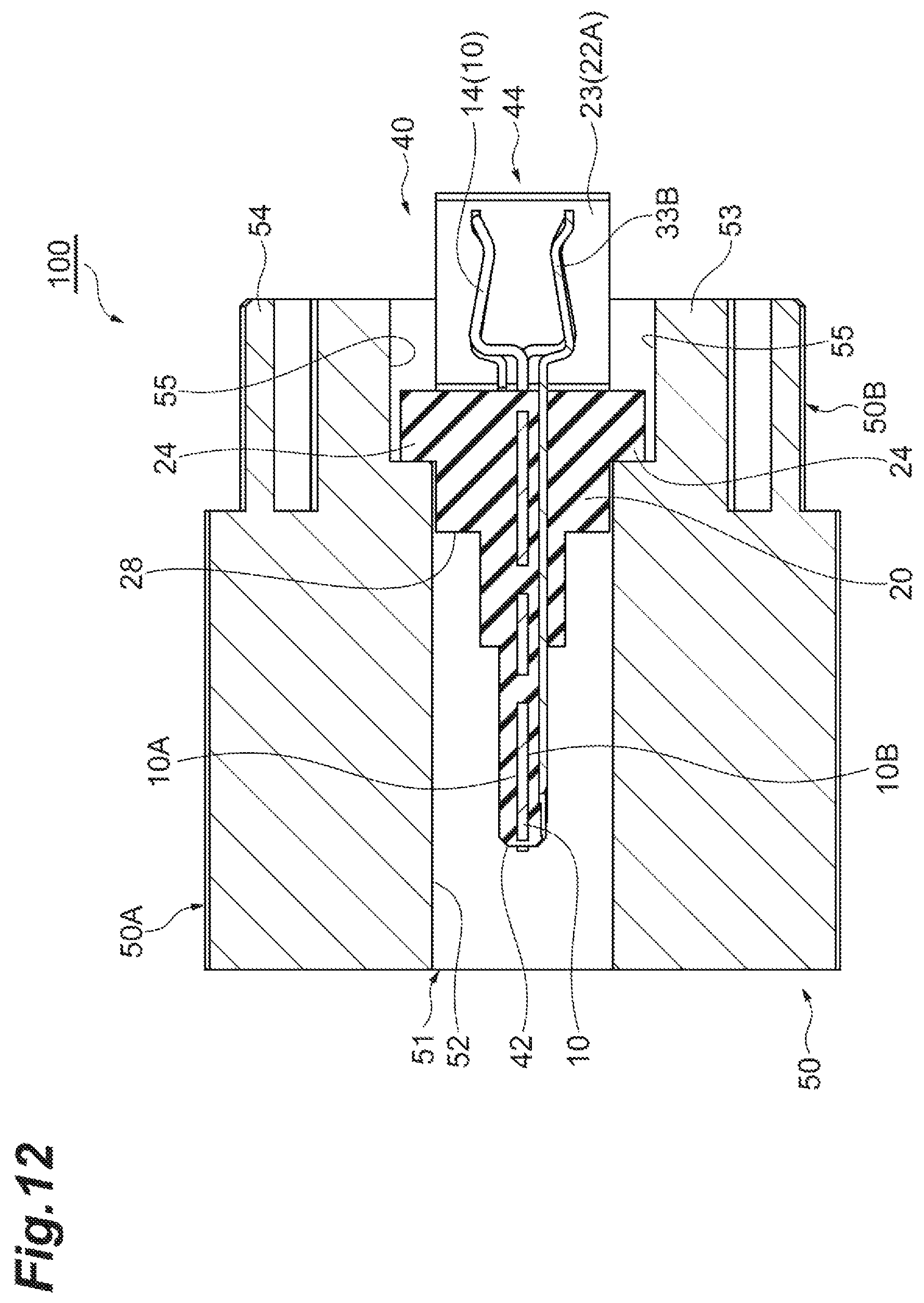
D00013
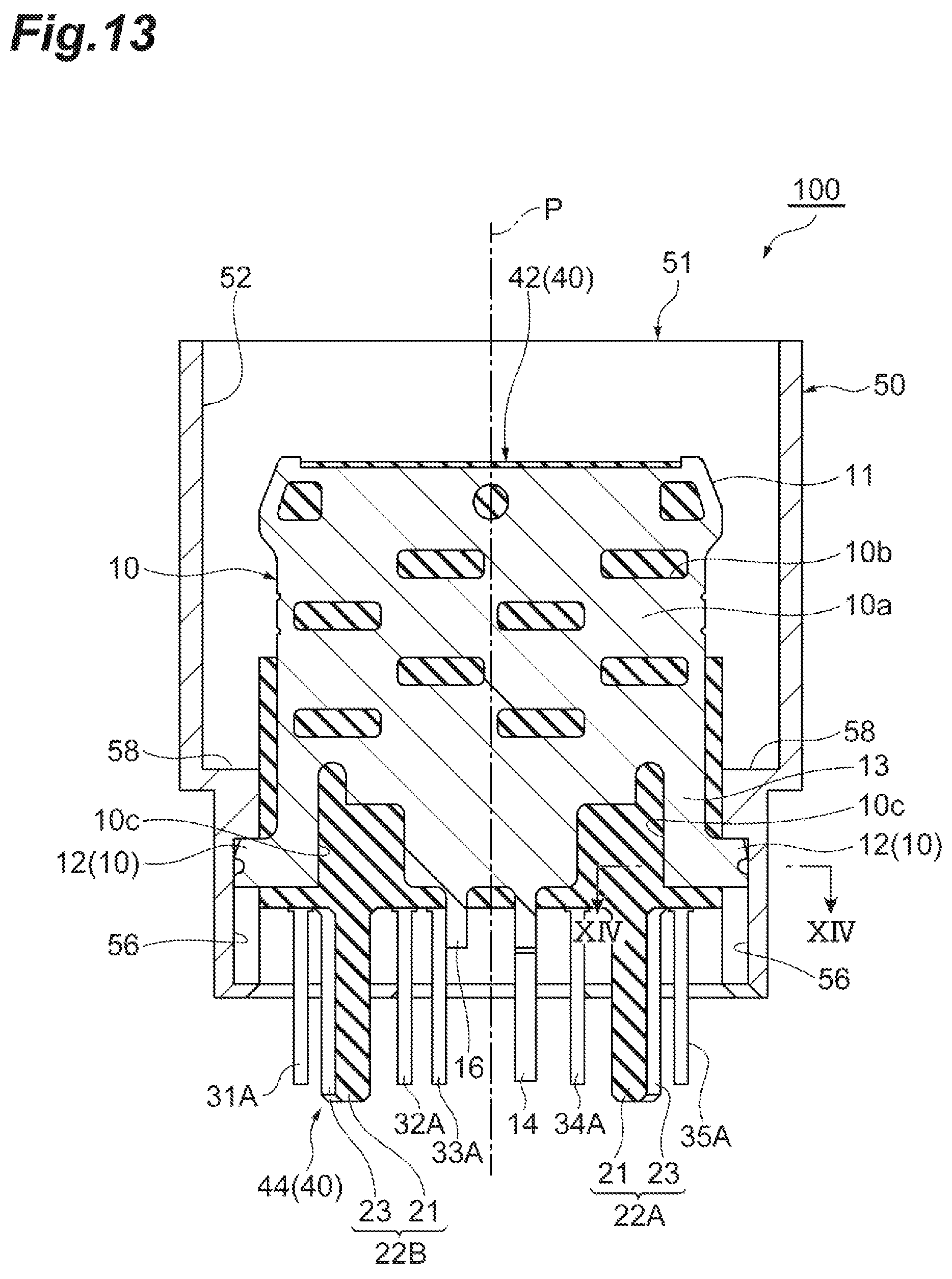
D00014
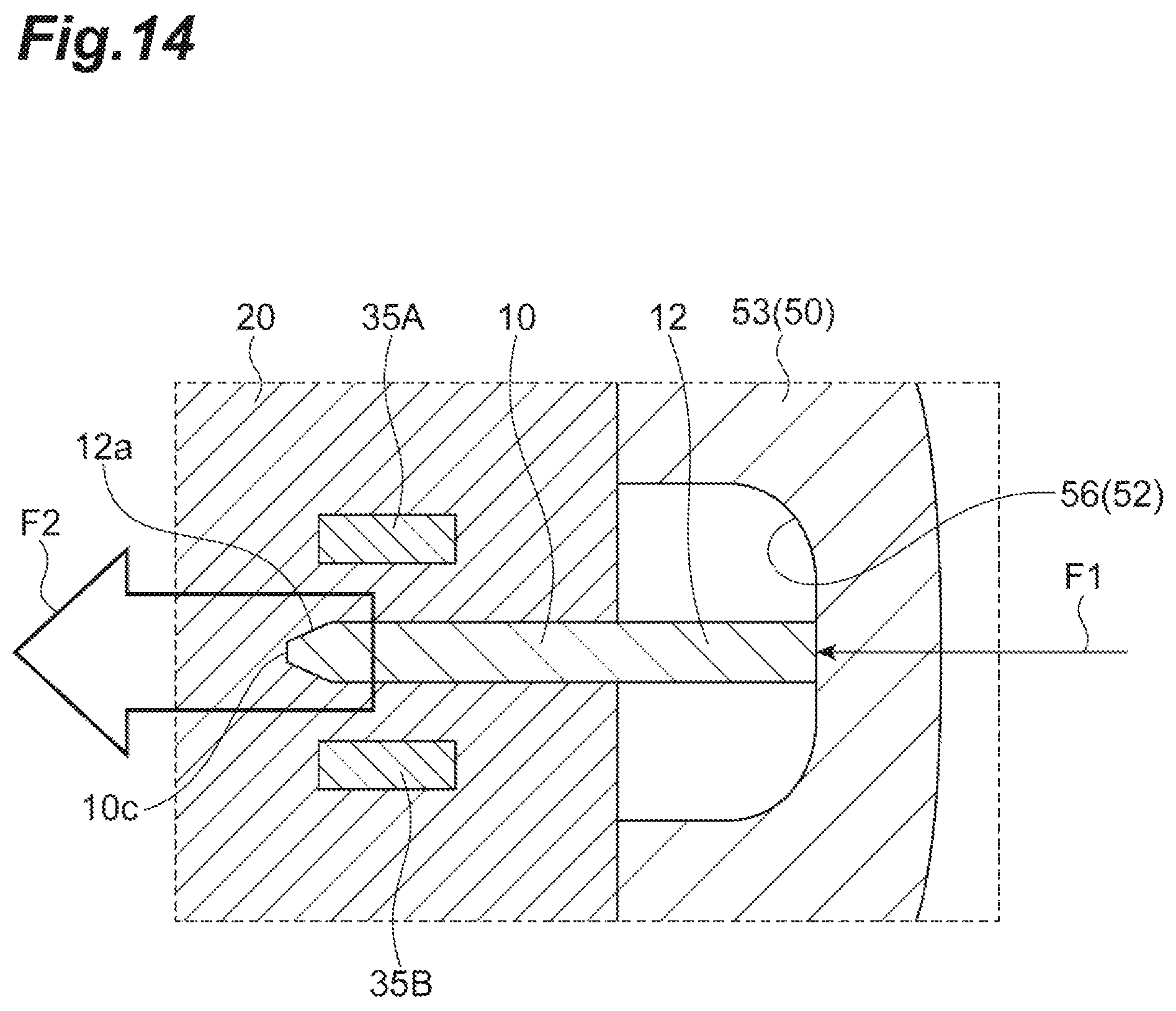
D00015
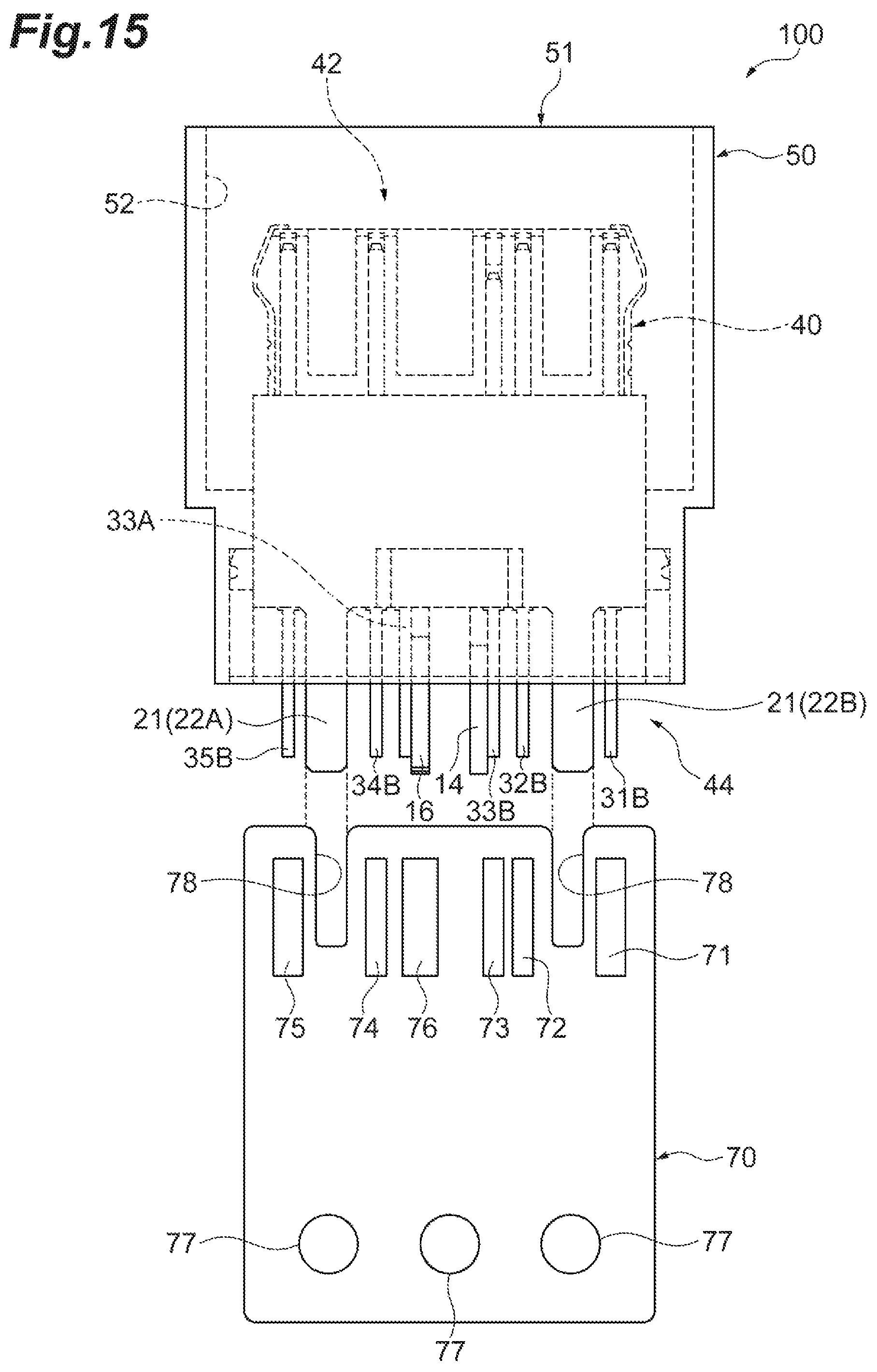
D00016
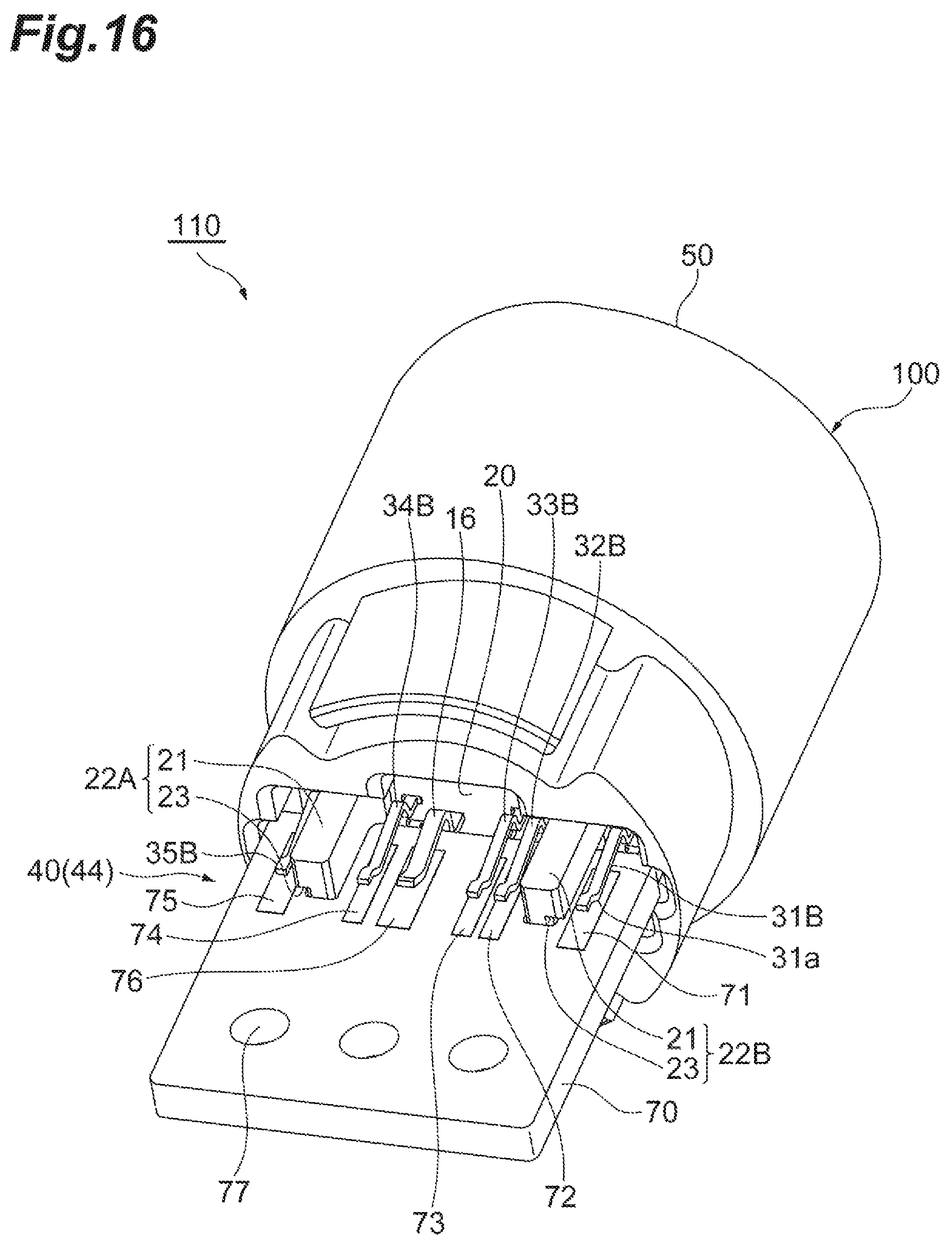
D00017
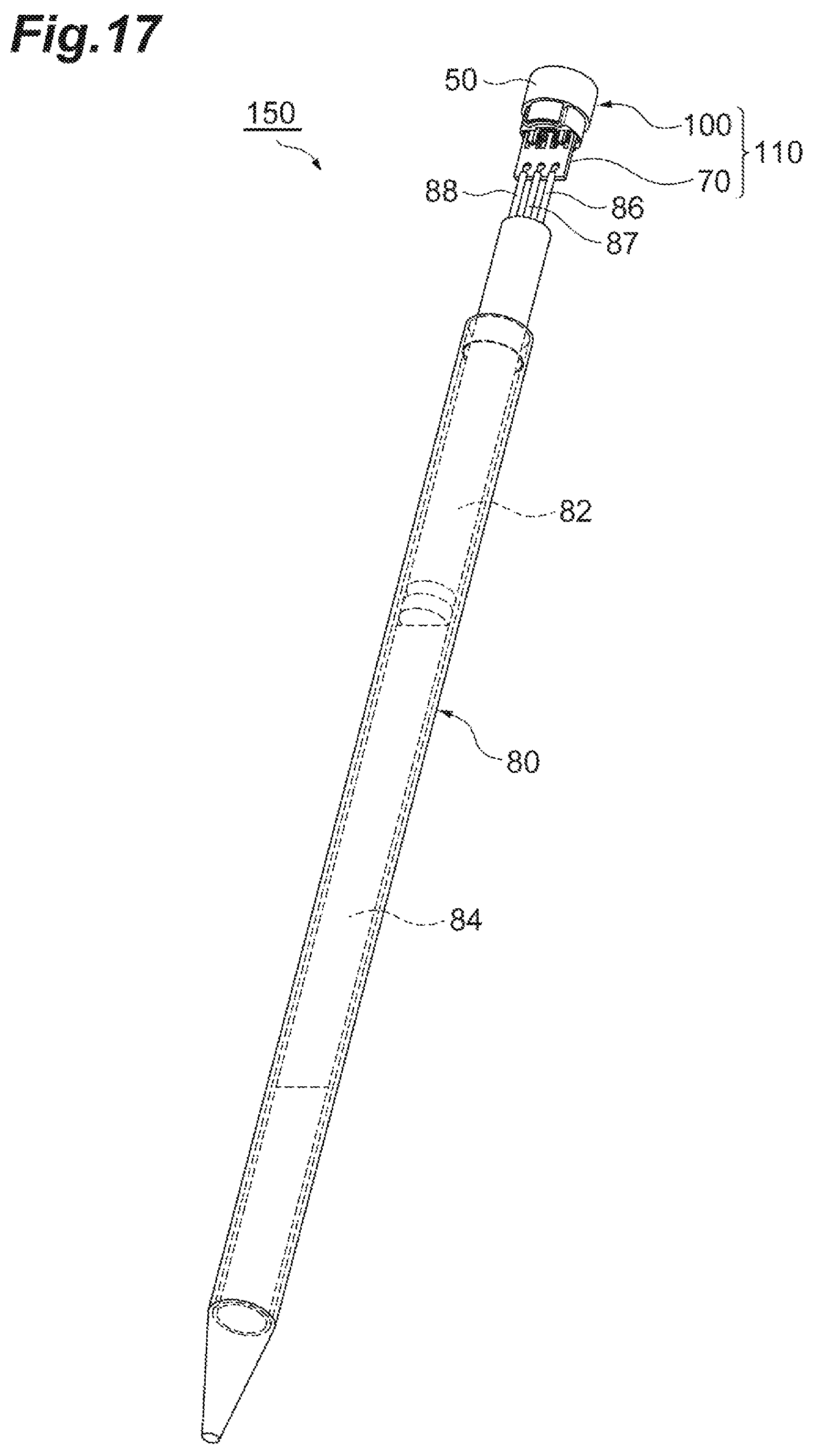
D00018
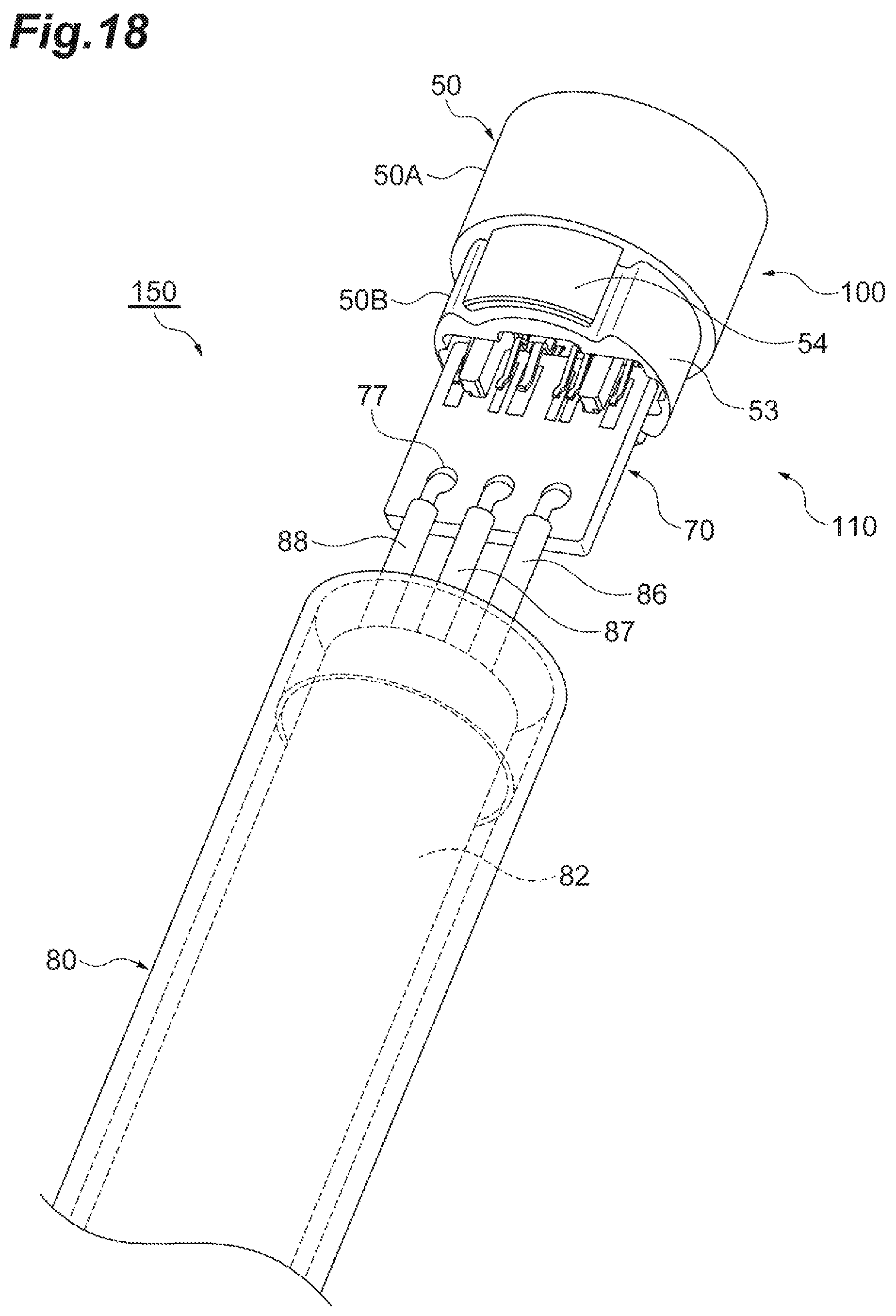
D00019
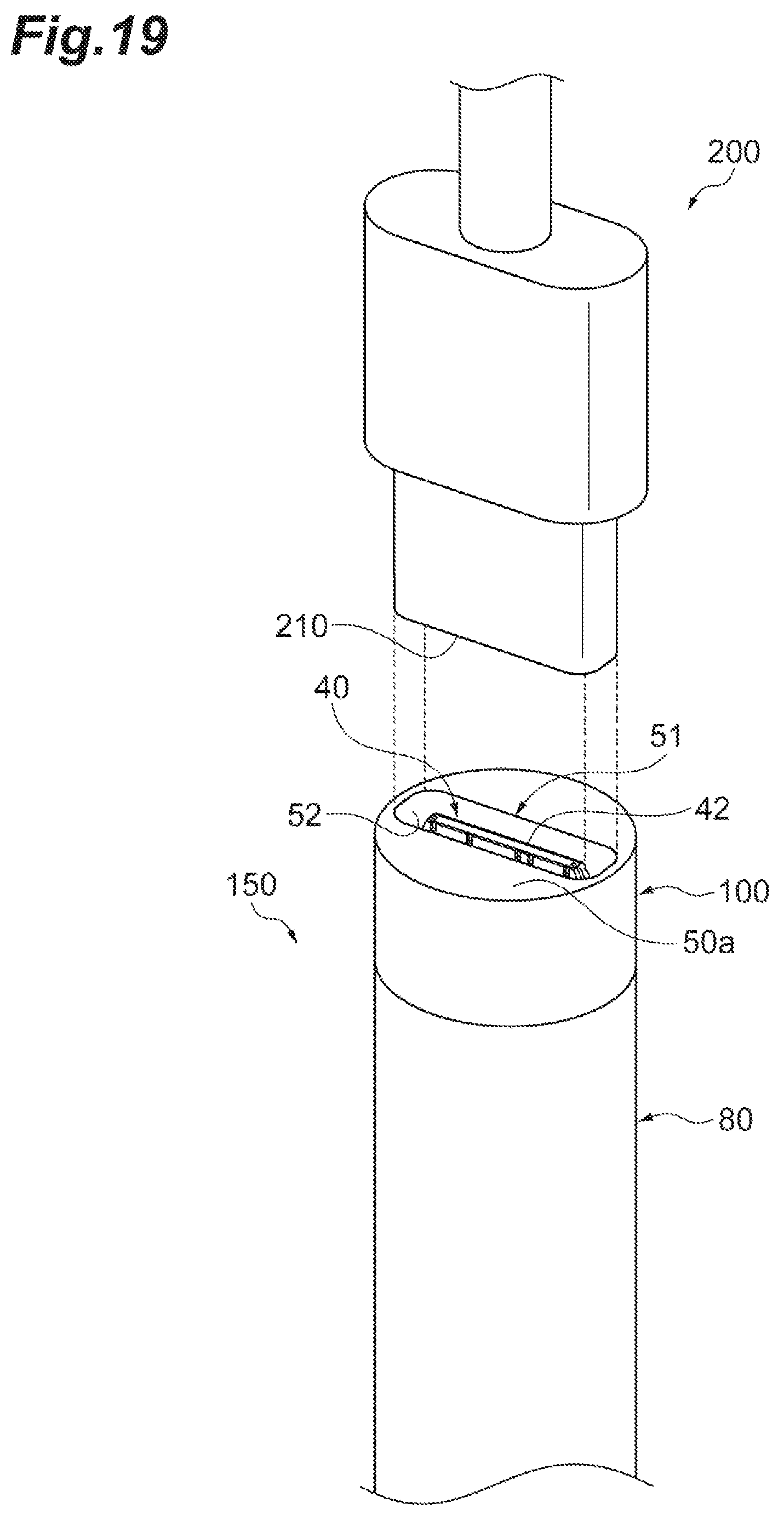
XML
uspto.report is an independent third-party trademark research tool that is not affiliated, endorsed, or sponsored by the United States Patent and Trademark Office (USPTO) or any other governmental organization. The information provided by uspto.report is based on publicly available data at the time of writing and is intended for informational purposes only.
While we strive to provide accurate and up-to-date information, we do not guarantee the accuracy, completeness, reliability, or suitability of the information displayed on this site. The use of this site is at your own risk. Any reliance you place on such information is therefore strictly at your own risk.
All official trademark data, including owner information, should be verified by visiting the official USPTO website at www.uspto.gov. This site is not intended to replace professional legal advice and should not be used as a substitute for consulting with a legal professional who is knowledgeable about trademark law.